The Major Health Care Deficiencies
VerifiedAdded on 2023/01/17
|23
|6462
|57
AI Summary
This article discusses the major health care deficiencies in the Victorian health care system and explores the related national safety and quality health service standards. It highlights the need for improvement in patient safety and quality of care.
Contribute Materials
Your contribution can guide someone’s learning journey. Share your
documents today.

Running head: THE MAJOR HEALTH CARE DEFICIENCIES
The Major Health Care Deficiencies
Name
Institution
Date
The Major Health Care Deficiencies
Name
Institution
Date
Secure Best Marks with AI Grader
Need help grading? Try our AI Grader for instant feedback on your assignments.
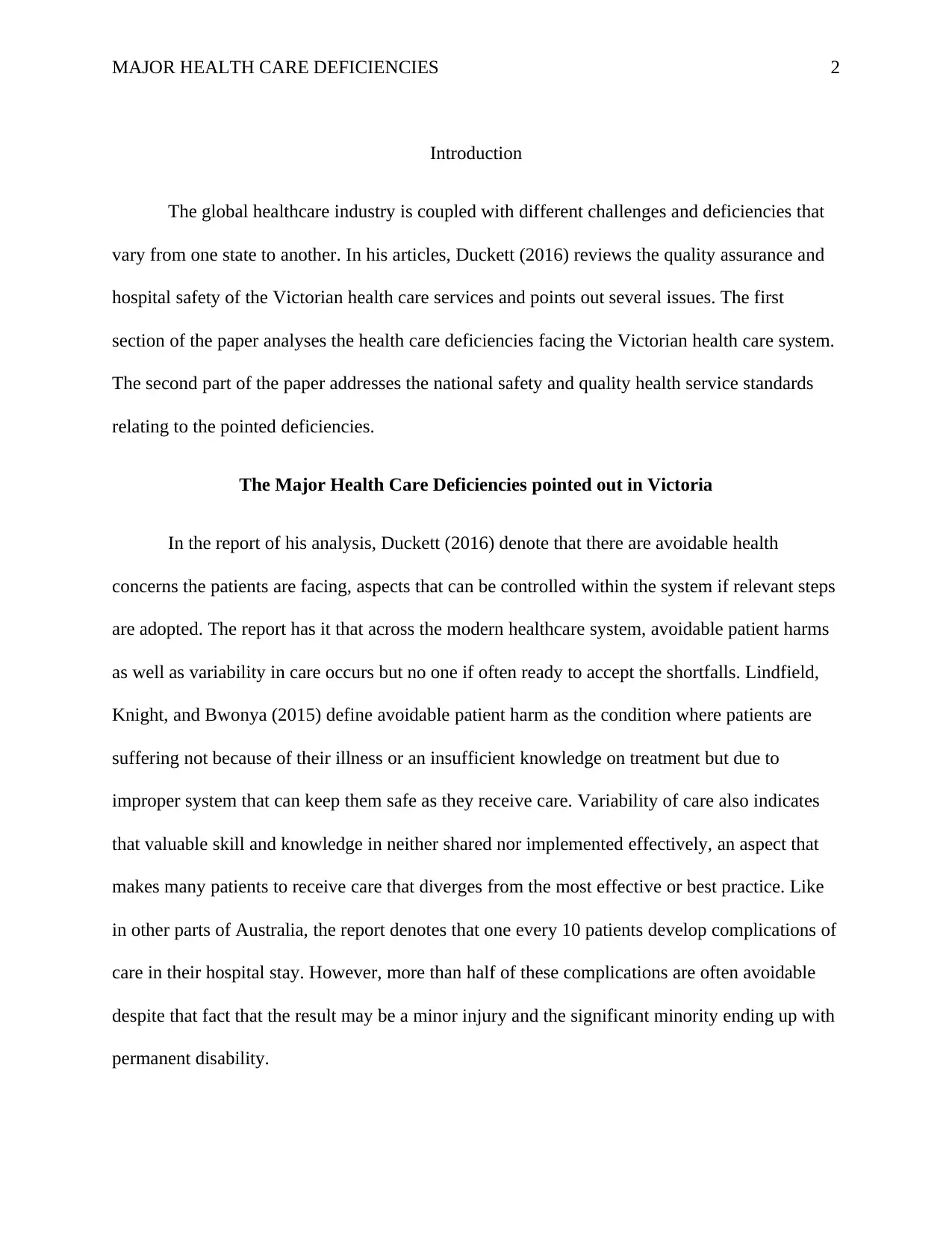
MAJOR HEALTH CARE DEFICIENCIES 2
Introduction
The global healthcare industry is coupled with different challenges and deficiencies that
vary from one state to another. In his articles, Duckett (2016) reviews the quality assurance and
hospital safety of the Victorian health care services and points out several issues. The first
section of the paper analyses the health care deficiencies facing the Victorian health care system.
The second part of the paper addresses the national safety and quality health service standards
relating to the pointed deficiencies.
The Major Health Care Deficiencies pointed out in Victoria
In the report of his analysis, Duckett (2016) denote that there are avoidable health
concerns the patients are facing, aspects that can be controlled within the system if relevant steps
are adopted. The report has it that across the modern healthcare system, avoidable patient harms
as well as variability in care occurs but no one if often ready to accept the shortfalls. Lindfield,
Knight, and Bwonya (2015) define avoidable patient harm as the condition where patients are
suffering not because of their illness or an insufficient knowledge on treatment but due to
improper system that can keep them safe as they receive care. Variability of care also indicates
that valuable skill and knowledge in neither shared nor implemented effectively, an aspect that
makes many patients to receive care that diverges from the most effective or best practice. Like
in other parts of Australia, the report denotes that one every 10 patients develop complications of
care in their hospital stay. However, more than half of these complications are often avoidable
despite that fact that the result may be a minor injury and the significant minority ending up with
permanent disability.
Introduction
The global healthcare industry is coupled with different challenges and deficiencies that
vary from one state to another. In his articles, Duckett (2016) reviews the quality assurance and
hospital safety of the Victorian health care services and points out several issues. The first
section of the paper analyses the health care deficiencies facing the Victorian health care system.
The second part of the paper addresses the national safety and quality health service standards
relating to the pointed deficiencies.
The Major Health Care Deficiencies pointed out in Victoria
In the report of his analysis, Duckett (2016) denote that there are avoidable health
concerns the patients are facing, aspects that can be controlled within the system if relevant steps
are adopted. The report has it that across the modern healthcare system, avoidable patient harms
as well as variability in care occurs but no one if often ready to accept the shortfalls. Lindfield,
Knight, and Bwonya (2015) define avoidable patient harm as the condition where patients are
suffering not because of their illness or an insufficient knowledge on treatment but due to
improper system that can keep them safe as they receive care. Variability of care also indicates
that valuable skill and knowledge in neither shared nor implemented effectively, an aspect that
makes many patients to receive care that diverges from the most effective or best practice. Like
in other parts of Australia, the report denotes that one every 10 patients develop complications of
care in their hospital stay. However, more than half of these complications are often avoidable
despite that fact that the result may be a minor injury and the significant minority ending up with
permanent disability.
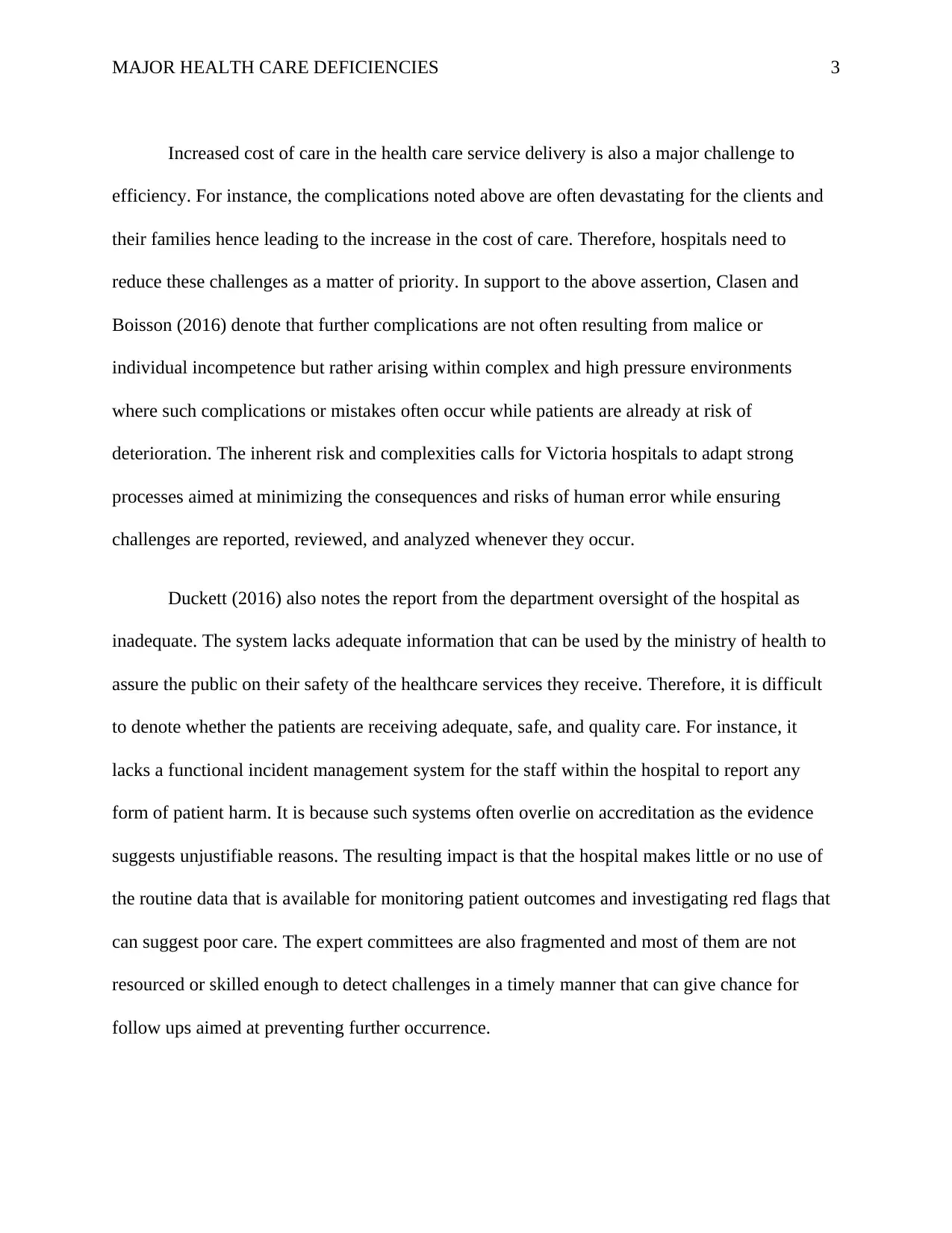
MAJOR HEALTH CARE DEFICIENCIES 3
Increased cost of care in the health care service delivery is also a major challenge to
efficiency. For instance, the complications noted above are often devastating for the clients and
their families hence leading to the increase in the cost of care. Therefore, hospitals need to
reduce these challenges as a matter of priority. In support to the above assertion, Clasen and
Boisson (2016) denote that further complications are not often resulting from malice or
individual incompetence but rather arising within complex and high pressure environments
where such complications or mistakes often occur while patients are already at risk of
deterioration. The inherent risk and complexities calls for Victoria hospitals to adapt strong
processes aimed at minimizing the consequences and risks of human error while ensuring
challenges are reported, reviewed, and analyzed whenever they occur.
Duckett (2016) also notes the report from the department oversight of the hospital as
inadequate. The system lacks adequate information that can be used by the ministry of health to
assure the public on their safety of the healthcare services they receive. Therefore, it is difficult
to denote whether the patients are receiving adequate, safe, and quality care. For instance, it
lacks a functional incident management system for the staff within the hospital to report any
form of patient harm. It is because such systems often overlie on accreditation as the evidence
suggests unjustifiable reasons. The resulting impact is that the hospital makes little or no use of
the routine data that is available for monitoring patient outcomes and investigating red flags that
can suggest poor care. The expert committees are also fragmented and most of them are not
resourced or skilled enough to detect challenges in a timely manner that can give chance for
follow ups aimed at preventing further occurrence.
Increased cost of care in the health care service delivery is also a major challenge to
efficiency. For instance, the complications noted above are often devastating for the clients and
their families hence leading to the increase in the cost of care. Therefore, hospitals need to
reduce these challenges as a matter of priority. In support to the above assertion, Clasen and
Boisson (2016) denote that further complications are not often resulting from malice or
individual incompetence but rather arising within complex and high pressure environments
where such complications or mistakes often occur while patients are already at risk of
deterioration. The inherent risk and complexities calls for Victoria hospitals to adapt strong
processes aimed at minimizing the consequences and risks of human error while ensuring
challenges are reported, reviewed, and analyzed whenever they occur.
Duckett (2016) also notes the report from the department oversight of the hospital as
inadequate. The system lacks adequate information that can be used by the ministry of health to
assure the public on their safety of the healthcare services they receive. Therefore, it is difficult
to denote whether the patients are receiving adequate, safe, and quality care. For instance, it
lacks a functional incident management system for the staff within the hospital to report any
form of patient harm. It is because such systems often overlie on accreditation as the evidence
suggests unjustifiable reasons. The resulting impact is that the hospital makes little or no use of
the routine data that is available for monitoring patient outcomes and investigating red flags that
can suggest poor care. The expert committees are also fragmented and most of them are not
resourced or skilled enough to detect challenges in a timely manner that can give chance for
follow ups aimed at preventing further occurrence.
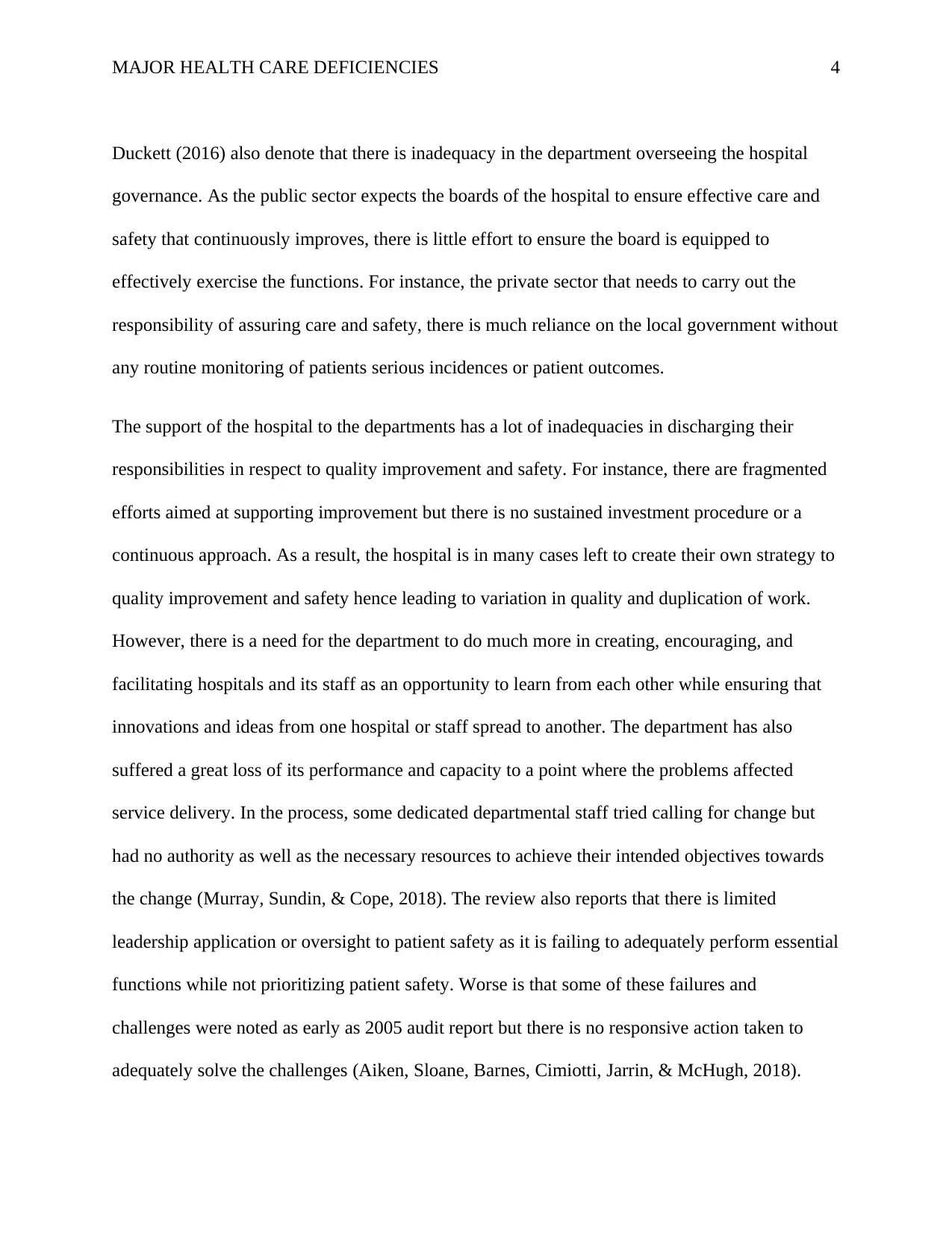
MAJOR HEALTH CARE DEFICIENCIES 4
Duckett (2016) also denote that there is inadequacy in the department overseeing the hospital
governance. As the public sector expects the boards of the hospital to ensure effective care and
safety that continuously improves, there is little effort to ensure the board is equipped to
effectively exercise the functions. For instance, the private sector that needs to carry out the
responsibility of assuring care and safety, there is much reliance on the local government without
any routine monitoring of patients serious incidences or patient outcomes.
The support of the hospital to the departments has a lot of inadequacies in discharging their
responsibilities in respect to quality improvement and safety. For instance, there are fragmented
efforts aimed at supporting improvement but there is no sustained investment procedure or a
continuous approach. As a result, the hospital is in many cases left to create their own strategy to
quality improvement and safety hence leading to variation in quality and duplication of work.
However, there is a need for the department to do much more in creating, encouraging, and
facilitating hospitals and its staff as an opportunity to learn from each other while ensuring that
innovations and ideas from one hospital or staff spread to another. The department has also
suffered a great loss of its performance and capacity to a point where the problems affected
service delivery. In the process, some dedicated departmental staff tried calling for change but
had no authority as well as the necessary resources to achieve their intended objectives towards
the change (Murray, Sundin, & Cope, 2018). The review also reports that there is limited
leadership application or oversight to patient safety as it is failing to adequately perform essential
functions while not prioritizing patient safety. Worse is that some of these failures and
challenges were noted as early as 2005 audit report but there is no responsive action taken to
adequately solve the challenges (Aiken, Sloane, Barnes, Cimiotti, Jarrin, & McHugh, 2018).
Duckett (2016) also denote that there is inadequacy in the department overseeing the hospital
governance. As the public sector expects the boards of the hospital to ensure effective care and
safety that continuously improves, there is little effort to ensure the board is equipped to
effectively exercise the functions. For instance, the private sector that needs to carry out the
responsibility of assuring care and safety, there is much reliance on the local government without
any routine monitoring of patients serious incidences or patient outcomes.
The support of the hospital to the departments has a lot of inadequacies in discharging their
responsibilities in respect to quality improvement and safety. For instance, there are fragmented
efforts aimed at supporting improvement but there is no sustained investment procedure or a
continuous approach. As a result, the hospital is in many cases left to create their own strategy to
quality improvement and safety hence leading to variation in quality and duplication of work.
However, there is a need for the department to do much more in creating, encouraging, and
facilitating hospitals and its staff as an opportunity to learn from each other while ensuring that
innovations and ideas from one hospital or staff spread to another. The department has also
suffered a great loss of its performance and capacity to a point where the problems affected
service delivery. In the process, some dedicated departmental staff tried calling for change but
had no authority as well as the necessary resources to achieve their intended objectives towards
the change (Murray, Sundin, & Cope, 2018). The review also reports that there is limited
leadership application or oversight to patient safety as it is failing to adequately perform essential
functions while not prioritizing patient safety. Worse is that some of these failures and
challenges were noted as early as 2005 audit report but there is no responsive action taken to
adequately solve the challenges (Aiken, Sloane, Barnes, Cimiotti, Jarrin, & McHugh, 2018).
Secure Best Marks with AI Grader
Need help grading? Try our AI Grader for instant feedback on your assignments.
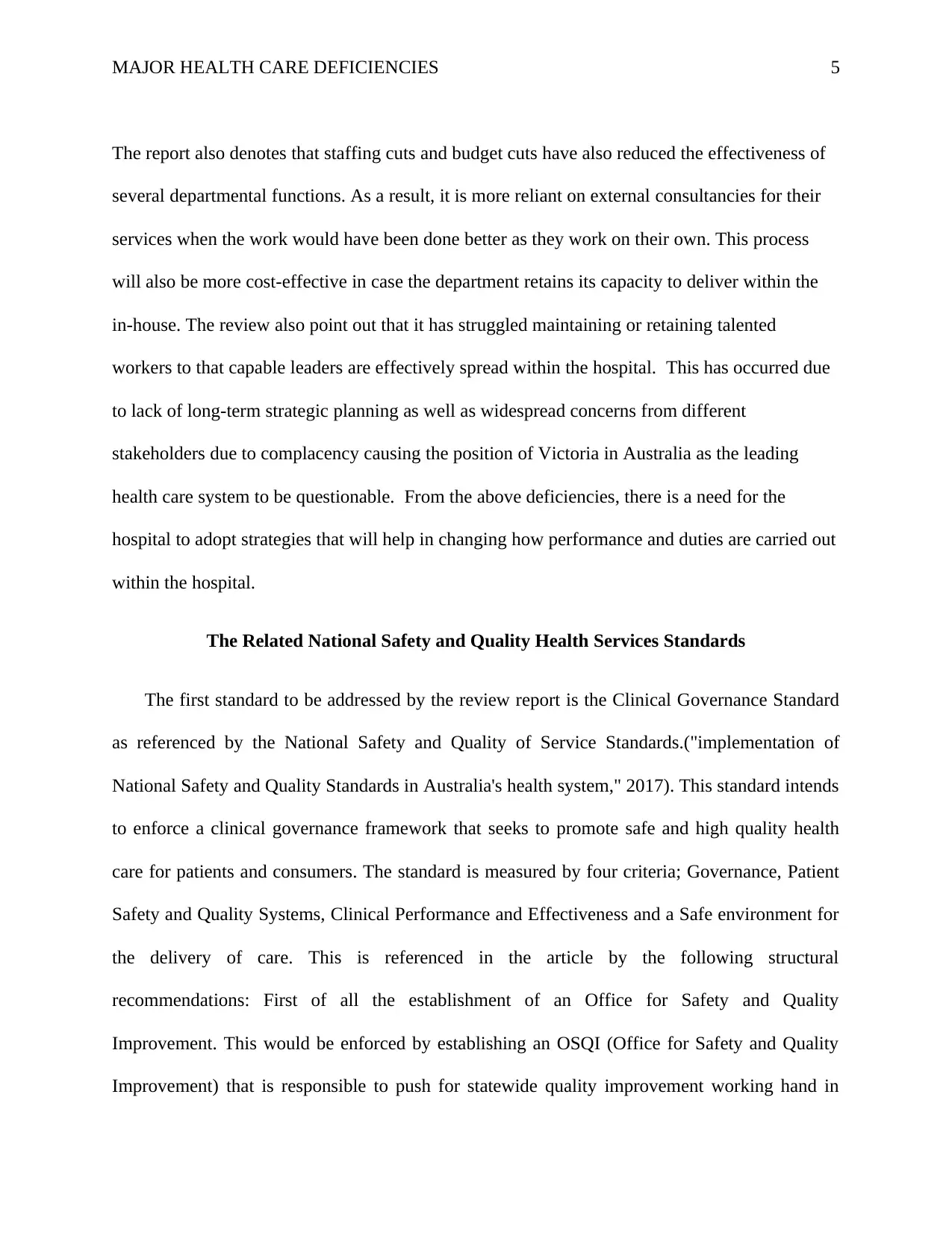
MAJOR HEALTH CARE DEFICIENCIES 5
The report also denotes that staffing cuts and budget cuts have also reduced the effectiveness of
several departmental functions. As a result, it is more reliant on external consultancies for their
services when the work would have been done better as they work on their own. This process
will also be more cost-effective in case the department retains its capacity to deliver within the
in-house. The review also point out that it has struggled maintaining or retaining talented
workers to that capable leaders are effectively spread within the hospital. This has occurred due
to lack of long-term strategic planning as well as widespread concerns from different
stakeholders due to complacency causing the position of Victoria in Australia as the leading
health care system to be questionable. From the above deficiencies, there is a need for the
hospital to adopt strategies that will help in changing how performance and duties are carried out
within the hospital.
The Related National Safety and Quality Health Services Standards
The first standard to be addressed by the review report is the Clinical Governance Standard
as referenced by the National Safety and Quality of Service Standards.("implementation of
National Safety and Quality Standards in Australia's health system," 2017). This standard intends
to enforce a clinical governance framework that seeks to promote safe and high quality health
care for patients and consumers. The standard is measured by four criteria; Governance, Patient
Safety and Quality Systems, Clinical Performance and Effectiveness and a Safe environment for
the delivery of care. This is referenced in the article by the following structural
recommendations: First of all the establishment of an Office for Safety and Quality
Improvement. This would be enforced by establishing an OSQI (Office for Safety and Quality
Improvement) that is responsible to push for statewide quality improvement working hand in
The report also denotes that staffing cuts and budget cuts have also reduced the effectiveness of
several departmental functions. As a result, it is more reliant on external consultancies for their
services when the work would have been done better as they work on their own. This process
will also be more cost-effective in case the department retains its capacity to deliver within the
in-house. The review also point out that it has struggled maintaining or retaining talented
workers to that capable leaders are effectively spread within the hospital. This has occurred due
to lack of long-term strategic planning as well as widespread concerns from different
stakeholders due to complacency causing the position of Victoria in Australia as the leading
health care system to be questionable. From the above deficiencies, there is a need for the
hospital to adopt strategies that will help in changing how performance and duties are carried out
within the hospital.
The Related National Safety and Quality Health Services Standards
The first standard to be addressed by the review report is the Clinical Governance Standard
as referenced by the National Safety and Quality of Service Standards.("implementation of
National Safety and Quality Standards in Australia's health system," 2017). This standard intends
to enforce a clinical governance framework that seeks to promote safe and high quality health
care for patients and consumers. The standard is measured by four criteria; Governance, Patient
Safety and Quality Systems, Clinical Performance and Effectiveness and a Safe environment for
the delivery of care. This is referenced in the article by the following structural
recommendations: First of all the establishment of an Office for Safety and Quality
Improvement. This would be enforced by establishing an OSQI (Office for Safety and Quality
Improvement) that is responsible to push for statewide quality improvement working hand in
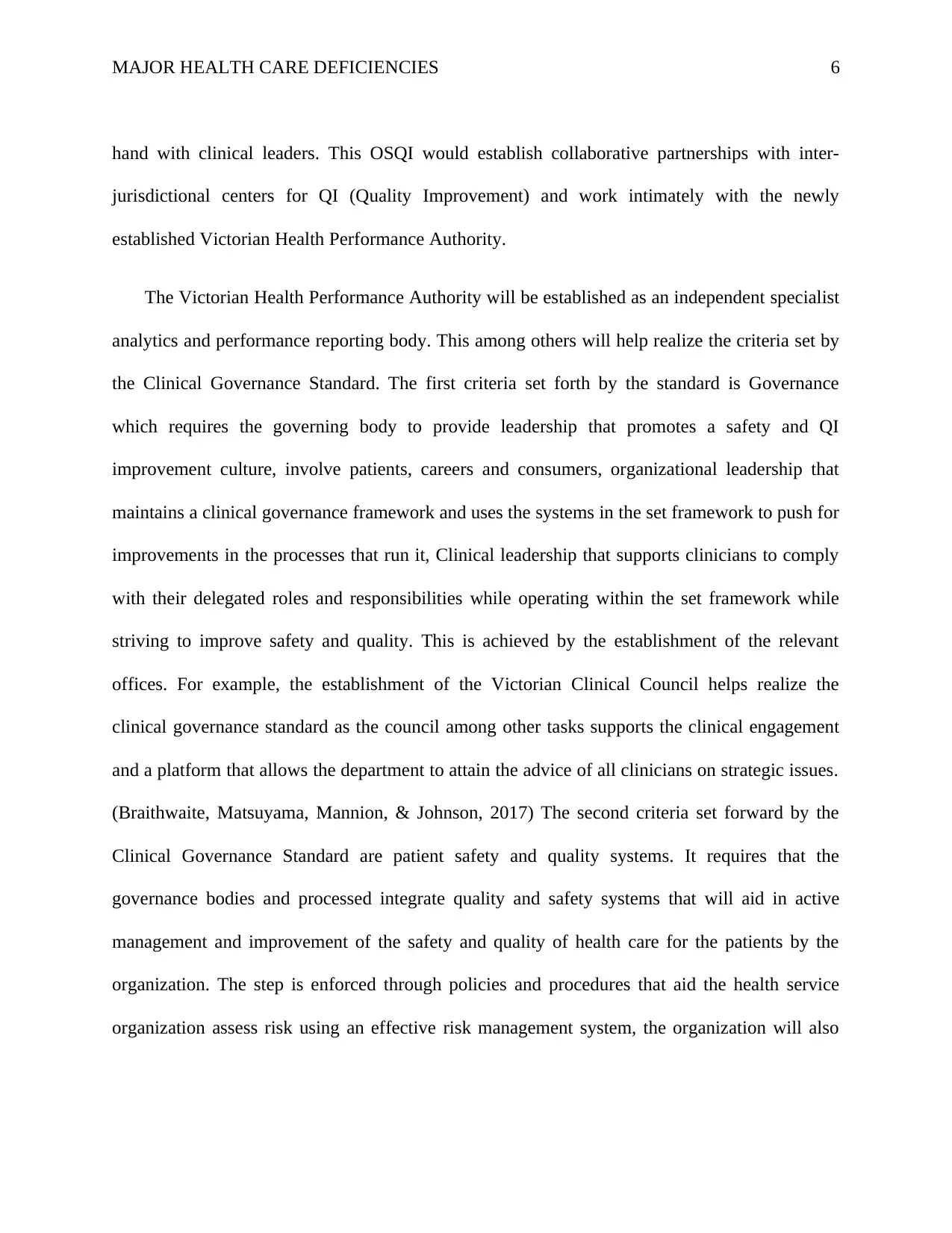
MAJOR HEALTH CARE DEFICIENCIES 6
hand with clinical leaders. This OSQI would establish collaborative partnerships with inter-
jurisdictional centers for QI (Quality Improvement) and work intimately with the newly
established Victorian Health Performance Authority.
The Victorian Health Performance Authority will be established as an independent specialist
analytics and performance reporting body. This among others will help realize the criteria set by
the Clinical Governance Standard. The first criteria set forth by the standard is Governance
which requires the governing body to provide leadership that promotes a safety and QI
improvement culture, involve patients, careers and consumers, organizational leadership that
maintains a clinical governance framework and uses the systems in the set framework to push for
improvements in the processes that run it, Clinical leadership that supports clinicians to comply
with their delegated roles and responsibilities while operating within the set framework while
striving to improve safety and quality. This is achieved by the establishment of the relevant
offices. For example, the establishment of the Victorian Clinical Council helps realize the
clinical governance standard as the council among other tasks supports the clinical engagement
and a platform that allows the department to attain the advice of all clinicians on strategic issues.
(Braithwaite, Matsuyama, Mannion, & Johnson, 2017) The second criteria set forward by the
Clinical Governance Standard are patient safety and quality systems. It requires that the
governance bodies and processed integrate quality and safety systems that will aid in active
management and improvement of the safety and quality of health care for the patients by the
organization. The step is enforced through policies and procedures that aid the health service
organization assess risk using an effective risk management system, the organization will also
hand with clinical leaders. This OSQI would establish collaborative partnerships with inter-
jurisdictional centers for QI (Quality Improvement) and work intimately with the newly
established Victorian Health Performance Authority.
The Victorian Health Performance Authority will be established as an independent specialist
analytics and performance reporting body. This among others will help realize the criteria set by
the Clinical Governance Standard. The first criteria set forth by the standard is Governance
which requires the governing body to provide leadership that promotes a safety and QI
improvement culture, involve patients, careers and consumers, organizational leadership that
maintains a clinical governance framework and uses the systems in the set framework to push for
improvements in the processes that run it, Clinical leadership that supports clinicians to comply
with their delegated roles and responsibilities while operating within the set framework while
striving to improve safety and quality. This is achieved by the establishment of the relevant
offices. For example, the establishment of the Victorian Clinical Council helps realize the
clinical governance standard as the council among other tasks supports the clinical engagement
and a platform that allows the department to attain the advice of all clinicians on strategic issues.
(Braithwaite, Matsuyama, Mannion, & Johnson, 2017) The second criteria set forward by the
Clinical Governance Standard are patient safety and quality systems. It requires that the
governance bodies and processed integrate quality and safety systems that will aid in active
management and improvement of the safety and quality of health care for the patients by the
organization. The step is enforced through policies and procedures that aid the health service
organization assess risk using an effective risk management system, the organization will also
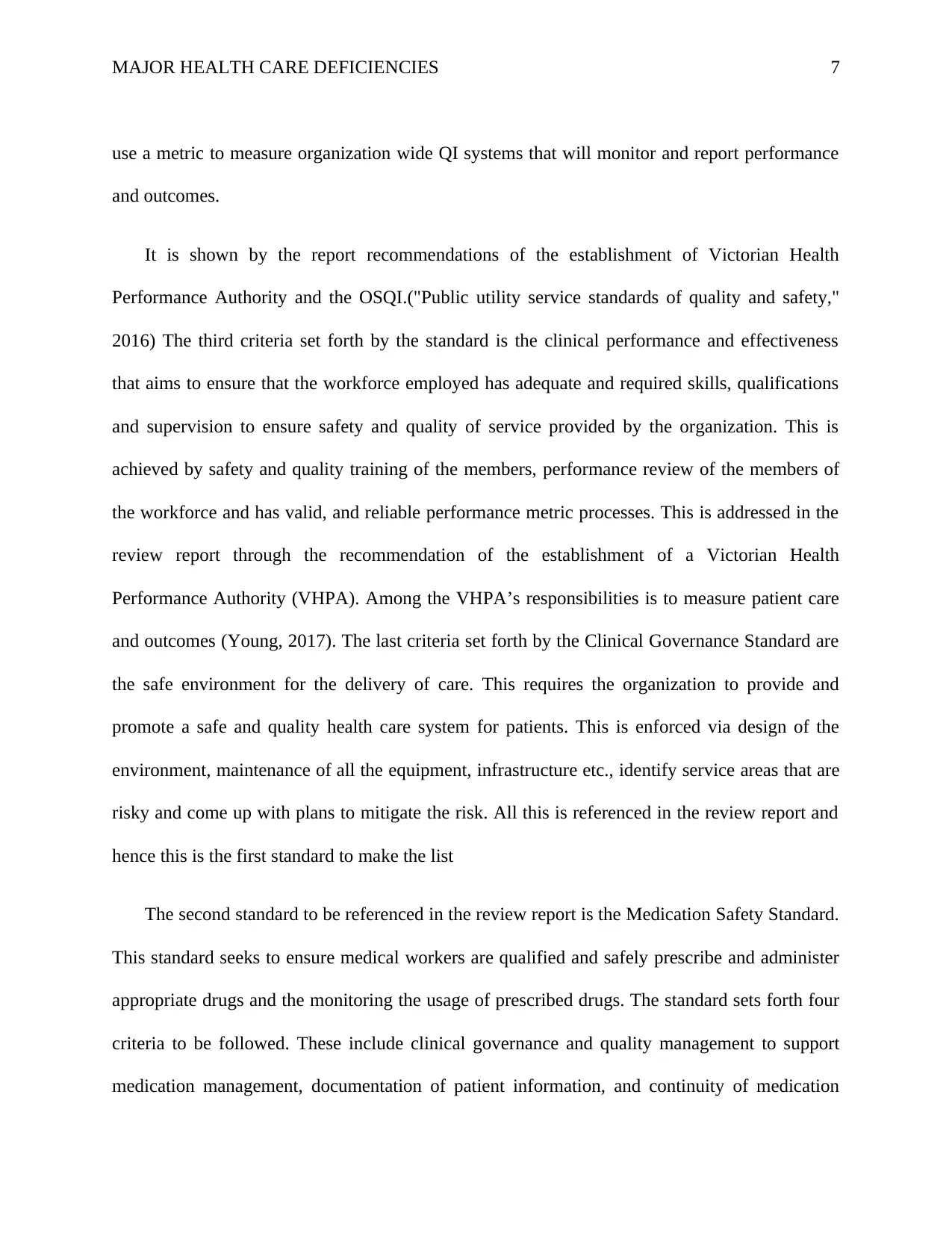
MAJOR HEALTH CARE DEFICIENCIES 7
use a metric to measure organization wide QI systems that will monitor and report performance
and outcomes.
It is shown by the report recommendations of the establishment of Victorian Health
Performance Authority and the OSQI.("Public utility service standards of quality and safety,"
2016) The third criteria set forth by the standard is the clinical performance and effectiveness
that aims to ensure that the workforce employed has adequate and required skills, qualifications
and supervision to ensure safety and quality of service provided by the organization. This is
achieved by safety and quality training of the members, performance review of the members of
the workforce and has valid, and reliable performance metric processes. This is addressed in the
review report through the recommendation of the establishment of a Victorian Health
Performance Authority (VHPA). Among the VHPA’s responsibilities is to measure patient care
and outcomes (Young, 2017). The last criteria set forth by the Clinical Governance Standard are
the safe environment for the delivery of care. This requires the organization to provide and
promote a safe and quality health care system for patients. This is enforced via design of the
environment, maintenance of all the equipment, infrastructure etc., identify service areas that are
risky and come up with plans to mitigate the risk. All this is referenced in the review report and
hence this is the first standard to make the list
The second standard to be referenced in the review report is the Medication Safety Standard.
This standard seeks to ensure medical workers are qualified and safely prescribe and administer
appropriate drugs and the monitoring the usage of prescribed drugs. The standard sets forth four
criteria to be followed. These include clinical governance and quality management to support
medication management, documentation of patient information, and continuity of medication
use a metric to measure organization wide QI systems that will monitor and report performance
and outcomes.
It is shown by the report recommendations of the establishment of Victorian Health
Performance Authority and the OSQI.("Public utility service standards of quality and safety,"
2016) The third criteria set forth by the standard is the clinical performance and effectiveness
that aims to ensure that the workforce employed has adequate and required skills, qualifications
and supervision to ensure safety and quality of service provided by the organization. This is
achieved by safety and quality training of the members, performance review of the members of
the workforce and has valid, and reliable performance metric processes. This is addressed in the
review report through the recommendation of the establishment of a Victorian Health
Performance Authority (VHPA). Among the VHPA’s responsibilities is to measure patient care
and outcomes (Young, 2017). The last criteria set forth by the Clinical Governance Standard are
the safe environment for the delivery of care. This requires the organization to provide and
promote a safe and quality health care system for patients. This is enforced via design of the
environment, maintenance of all the equipment, infrastructure etc., identify service areas that are
risky and come up with plans to mitigate the risk. All this is referenced in the review report and
hence this is the first standard to make the list
The second standard to be referenced in the review report is the Medication Safety Standard.
This standard seeks to ensure medical workers are qualified and safely prescribe and administer
appropriate drugs and the monitoring the usage of prescribed drugs. The standard sets forth four
criteria to be followed. These include clinical governance and quality management to support
medication management, documentation of patient information, and continuity of medication
Paraphrase This Document
Need a fresh take? Get an instant paraphrase of this document with our AI Paraphraser
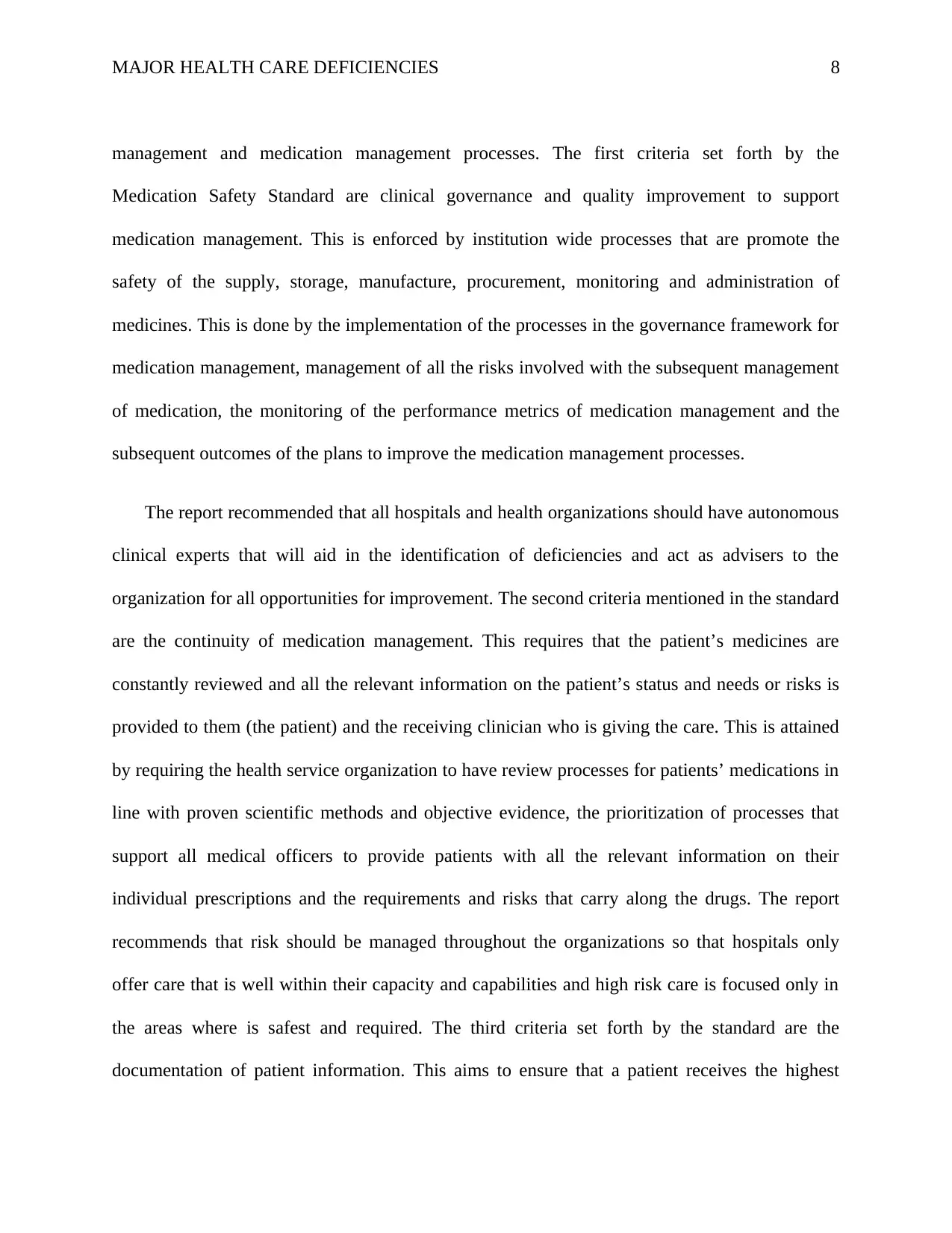
MAJOR HEALTH CARE DEFICIENCIES 8
management and medication management processes. The first criteria set forth by the
Medication Safety Standard are clinical governance and quality improvement to support
medication management. This is enforced by institution wide processes that are promote the
safety of the supply, storage, manufacture, procurement, monitoring and administration of
medicines. This is done by the implementation of the processes in the governance framework for
medication management, management of all the risks involved with the subsequent management
of medication, the monitoring of the performance metrics of medication management and the
subsequent outcomes of the plans to improve the medication management processes.
The report recommended that all hospitals and health organizations should have autonomous
clinical experts that will aid in the identification of deficiencies and act as advisers to the
organization for all opportunities for improvement. The second criteria mentioned in the standard
are the continuity of medication management. This requires that the patient’s medicines are
constantly reviewed and all the relevant information on the patient’s status and needs or risks is
provided to them (the patient) and the receiving clinician who is giving the care. This is attained
by requiring the health service organization to have review processes for patients’ medications in
line with proven scientific methods and objective evidence, the prioritization of processes that
support all medical officers to provide patients with all the relevant information on their
individual prescriptions and the requirements and risks that carry along the drugs. The report
recommends that risk should be managed throughout the organizations so that hospitals only
offer care that is well within their capacity and capabilities and high risk care is focused only in
the areas where is safest and required. The third criteria set forth by the standard are the
documentation of patient information. This aims to ensure that a patient receives the highest
management and medication management processes. The first criteria set forth by the
Medication Safety Standard are clinical governance and quality improvement to support
medication management. This is enforced by institution wide processes that are promote the
safety of the supply, storage, manufacture, procurement, monitoring and administration of
medicines. This is done by the implementation of the processes in the governance framework for
medication management, management of all the risks involved with the subsequent management
of medication, the monitoring of the performance metrics of medication management and the
subsequent outcomes of the plans to improve the medication management processes.
The report recommended that all hospitals and health organizations should have autonomous
clinical experts that will aid in the identification of deficiencies and act as advisers to the
organization for all opportunities for improvement. The second criteria mentioned in the standard
are the continuity of medication management. This requires that the patient’s medicines are
constantly reviewed and all the relevant information on the patient’s status and needs or risks is
provided to them (the patient) and the receiving clinician who is giving the care. This is attained
by requiring the health service organization to have review processes for patients’ medications in
line with proven scientific methods and objective evidence, the prioritization of processes that
support all medical officers to provide patients with all the relevant information on their
individual prescriptions and the requirements and risks that carry along the drugs. The report
recommends that risk should be managed throughout the organizations so that hospitals only
offer care that is well within their capacity and capabilities and high risk care is focused only in
the areas where is safest and required. The third criteria set forth by the standard are the
documentation of patient information. This aims to ensure that a patient receives the highest
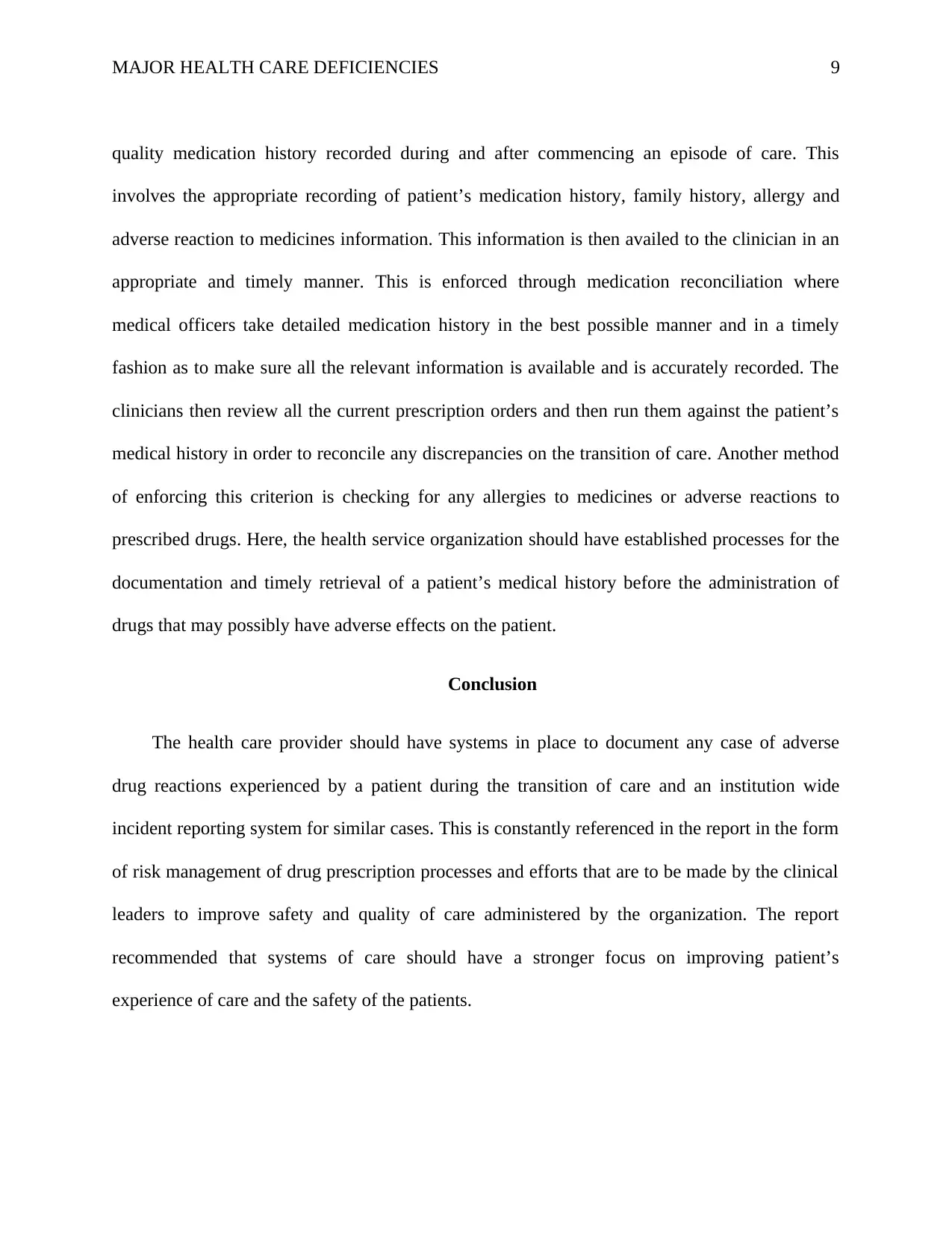
MAJOR HEALTH CARE DEFICIENCIES 9
quality medication history recorded during and after commencing an episode of care. This
involves the appropriate recording of patient’s medication history, family history, allergy and
adverse reaction to medicines information. This information is then availed to the clinician in an
appropriate and timely manner. This is enforced through medication reconciliation where
medical officers take detailed medication history in the best possible manner and in a timely
fashion as to make sure all the relevant information is available and is accurately recorded. The
clinicians then review all the current prescription orders and then run them against the patient’s
medical history in order to reconcile any discrepancies on the transition of care. Another method
of enforcing this criterion is checking for any allergies to medicines or adverse reactions to
prescribed drugs. Here, the health service organization should have established processes for the
documentation and timely retrieval of a patient’s medical history before the administration of
drugs that may possibly have adverse effects on the patient.
Conclusion
The health care provider should have systems in place to document any case of adverse
drug reactions experienced by a patient during the transition of care and an institution wide
incident reporting system for similar cases. This is constantly referenced in the report in the form
of risk management of drug prescription processes and efforts that are to be made by the clinical
leaders to improve safety and quality of care administered by the organization. The report
recommended that systems of care should have a stronger focus on improving patient’s
experience of care and the safety of the patients.
quality medication history recorded during and after commencing an episode of care. This
involves the appropriate recording of patient’s medication history, family history, allergy and
adverse reaction to medicines information. This information is then availed to the clinician in an
appropriate and timely manner. This is enforced through medication reconciliation where
medical officers take detailed medication history in the best possible manner and in a timely
fashion as to make sure all the relevant information is available and is accurately recorded. The
clinicians then review all the current prescription orders and then run them against the patient’s
medical history in order to reconcile any discrepancies on the transition of care. Another method
of enforcing this criterion is checking for any allergies to medicines or adverse reactions to
prescribed drugs. Here, the health service organization should have established processes for the
documentation and timely retrieval of a patient’s medical history before the administration of
drugs that may possibly have adverse effects on the patient.
Conclusion
The health care provider should have systems in place to document any case of adverse
drug reactions experienced by a patient during the transition of care and an institution wide
incident reporting system for similar cases. This is constantly referenced in the report in the form
of risk management of drug prescription processes and efforts that are to be made by the clinical
leaders to improve safety and quality of care administered by the organization. The report
recommended that systems of care should have a stronger focus on improving patient’s
experience of care and the safety of the patients.
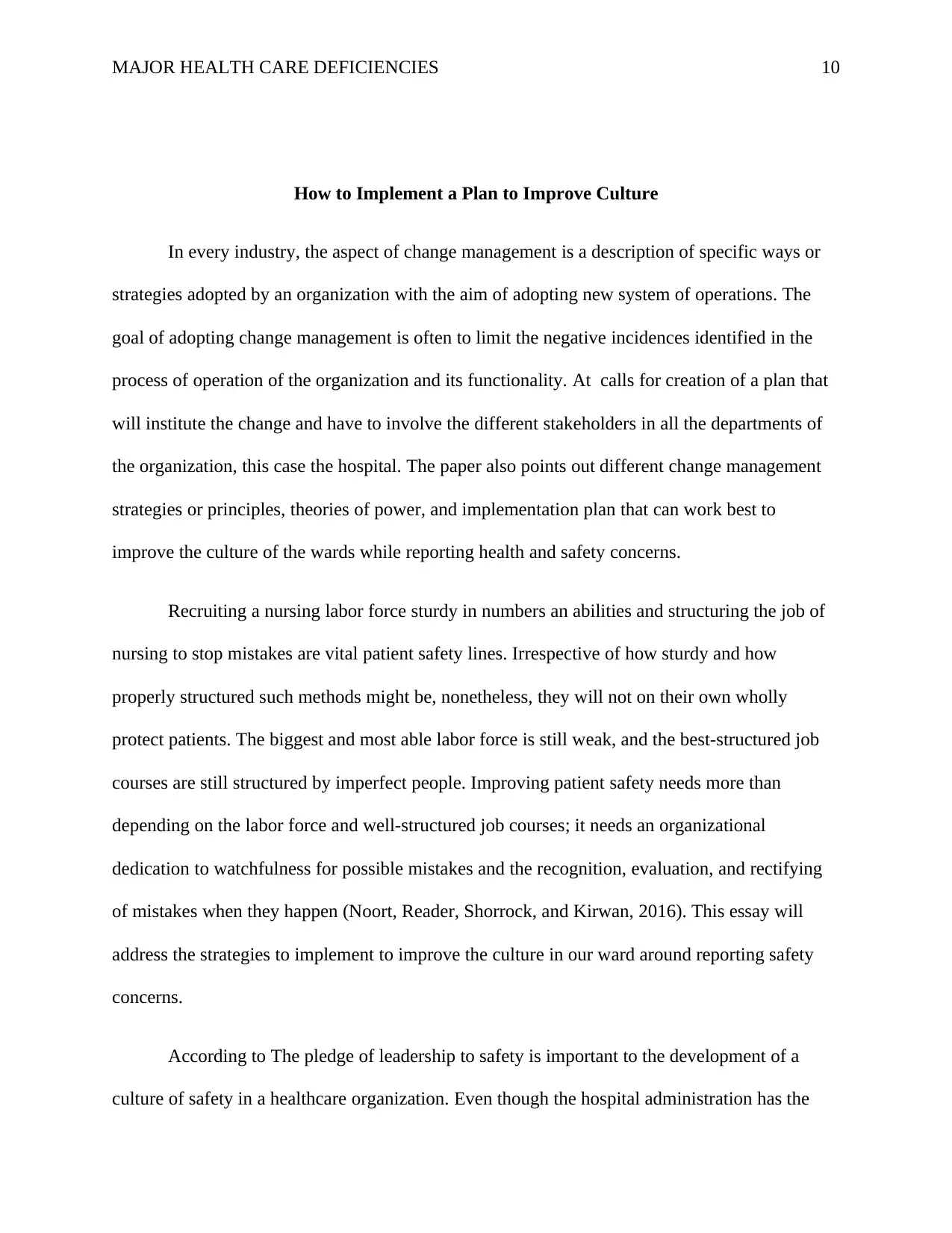
MAJOR HEALTH CARE DEFICIENCIES 10
How to Implement a Plan to Improve Culture
In every industry, the aspect of change management is a description of specific ways or
strategies adopted by an organization with the aim of adopting new system of operations. The
goal of adopting change management is often to limit the negative incidences identified in the
process of operation of the organization and its functionality. At calls for creation of a plan that
will institute the change and have to involve the different stakeholders in all the departments of
the organization, this case the hospital. The paper also points out different change management
strategies or principles, theories of power, and implementation plan that can work best to
improve the culture of the wards while reporting health and safety concerns.
Recruiting a nursing labor force sturdy in numbers an abilities and structuring the job of
nursing to stop mistakes are vital patient safety lines. Irrespective of how sturdy and how
properly structured such methods might be, nonetheless, they will not on their own wholly
protect patients. The biggest and most able labor force is still weak, and the best-structured job
courses are still structured by imperfect people. Improving patient safety needs more than
depending on the labor force and well-structured job courses; it needs an organizational
dedication to watchfulness for possible mistakes and the recognition, evaluation, and rectifying
of mistakes when they happen (Noort, Reader, Shorrock, and Kirwan, 2016). This essay will
address the strategies to implement to improve the culture in our ward around reporting safety
concerns.
According to The pledge of leadership to safety is important to the development of a
culture of safety in a healthcare organization. Even though the hospital administration has the
How to Implement a Plan to Improve Culture
In every industry, the aspect of change management is a description of specific ways or
strategies adopted by an organization with the aim of adopting new system of operations. The
goal of adopting change management is often to limit the negative incidences identified in the
process of operation of the organization and its functionality. At calls for creation of a plan that
will institute the change and have to involve the different stakeholders in all the departments of
the organization, this case the hospital. The paper also points out different change management
strategies or principles, theories of power, and implementation plan that can work best to
improve the culture of the wards while reporting health and safety concerns.
Recruiting a nursing labor force sturdy in numbers an abilities and structuring the job of
nursing to stop mistakes are vital patient safety lines. Irrespective of how sturdy and how
properly structured such methods might be, nonetheless, they will not on their own wholly
protect patients. The biggest and most able labor force is still weak, and the best-structured job
courses are still structured by imperfect people. Improving patient safety needs more than
depending on the labor force and well-structured job courses; it needs an organizational
dedication to watchfulness for possible mistakes and the recognition, evaluation, and rectifying
of mistakes when they happen (Noort, Reader, Shorrock, and Kirwan, 2016). This essay will
address the strategies to implement to improve the culture in our ward around reporting safety
concerns.
According to The pledge of leadership to safety is important to the development of a
culture of safety in a healthcare organization. Even though the hospital administration has the
Secure Best Marks with AI Grader
Need help grading? Try our AI Grader for instant feedback on your assignments.
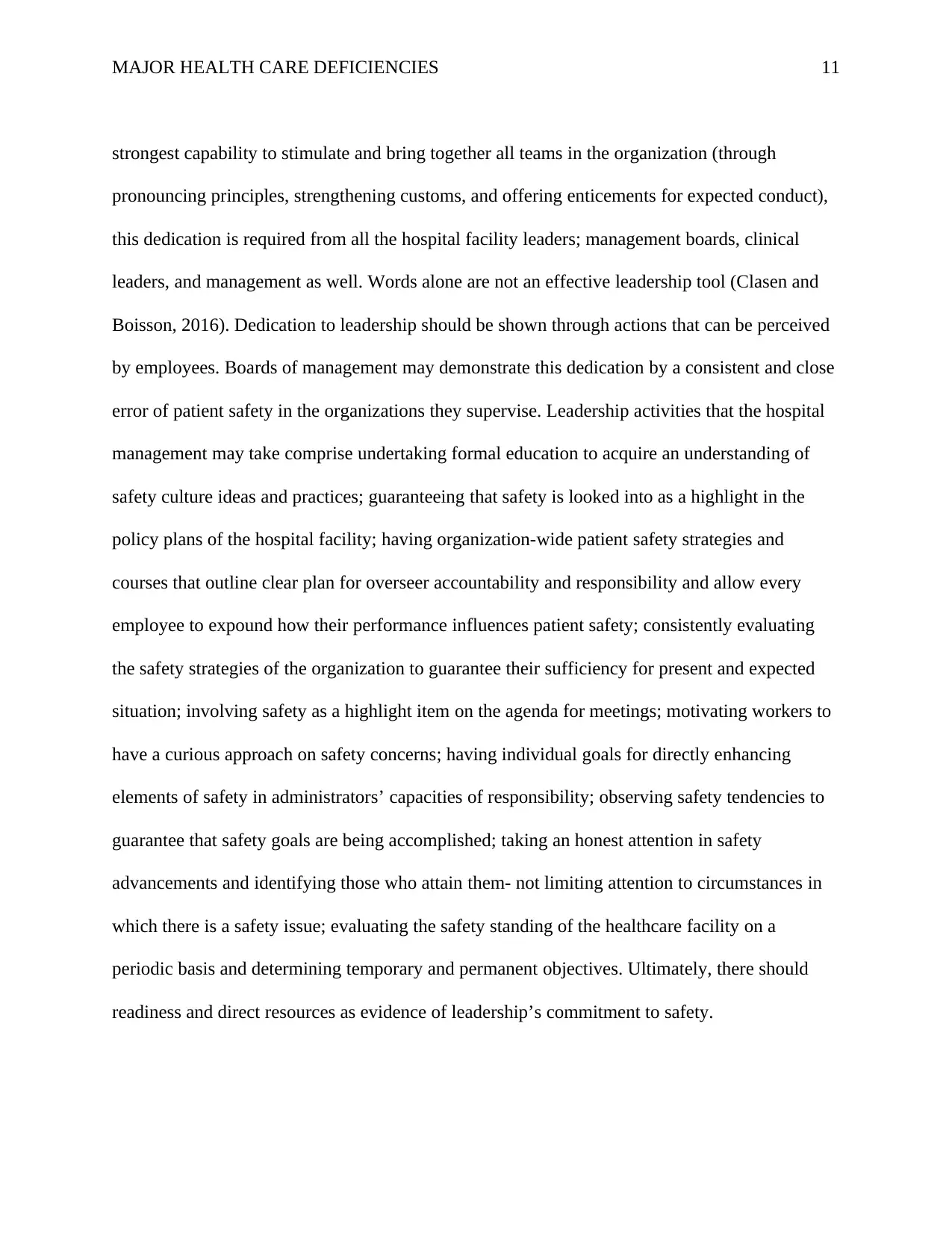
MAJOR HEALTH CARE DEFICIENCIES 11
strongest capability to stimulate and bring together all teams in the organization (through
pronouncing principles, strengthening customs, and offering enticements for expected conduct),
this dedication is required from all the hospital facility leaders; management boards, clinical
leaders, and management as well. Words alone are not an effective leadership tool (Clasen and
Boisson, 2016). Dedication to leadership should be shown through actions that can be perceived
by employees. Boards of management may demonstrate this dedication by a consistent and close
error of patient safety in the organizations they supervise. Leadership activities that the hospital
management may take comprise undertaking formal education to acquire an understanding of
safety culture ideas and practices; guaranteeing that safety is looked into as a highlight in the
policy plans of the hospital facility; having organization-wide patient safety strategies and
courses that outline clear plan for overseer accountability and responsibility and allow every
employee to expound how their performance influences patient safety; consistently evaluating
the safety strategies of the organization to guarantee their sufficiency for present and expected
situation; involving safety as a highlight item on the agenda for meetings; motivating workers to
have a curious approach on safety concerns; having individual goals for directly enhancing
elements of safety in administrators’ capacities of responsibility; observing safety tendencies to
guarantee that safety goals are being accomplished; taking an honest attention in safety
advancements and identifying those who attain them- not limiting attention to circumstances in
which there is a safety issue; evaluating the safety standing of the healthcare facility on a
periodic basis and determining temporary and permanent objectives. Ultimately, there should
readiness and direct resources as evidence of leadership’s commitment to safety.
strongest capability to stimulate and bring together all teams in the organization (through
pronouncing principles, strengthening customs, and offering enticements for expected conduct),
this dedication is required from all the hospital facility leaders; management boards, clinical
leaders, and management as well. Words alone are not an effective leadership tool (Clasen and
Boisson, 2016). Dedication to leadership should be shown through actions that can be perceived
by employees. Boards of management may demonstrate this dedication by a consistent and close
error of patient safety in the organizations they supervise. Leadership activities that the hospital
management may take comprise undertaking formal education to acquire an understanding of
safety culture ideas and practices; guaranteeing that safety is looked into as a highlight in the
policy plans of the hospital facility; having organization-wide patient safety strategies and
courses that outline clear plan for overseer accountability and responsibility and allow every
employee to expound how their performance influences patient safety; consistently evaluating
the safety strategies of the organization to guarantee their sufficiency for present and expected
situation; involving safety as a highlight item on the agenda for meetings; motivating workers to
have a curious approach on safety concerns; having individual goals for directly enhancing
elements of safety in administrators’ capacities of responsibility; observing safety tendencies to
guarantee that safety goals are being accomplished; taking an honest attention in safety
advancements and identifying those who attain them- not limiting attention to circumstances in
which there is a safety issue; evaluating the safety standing of the healthcare facility on a
periodic basis and determining temporary and permanent objectives. Ultimately, there should
readiness and direct resources as evidence of leadership’s commitment to safety.
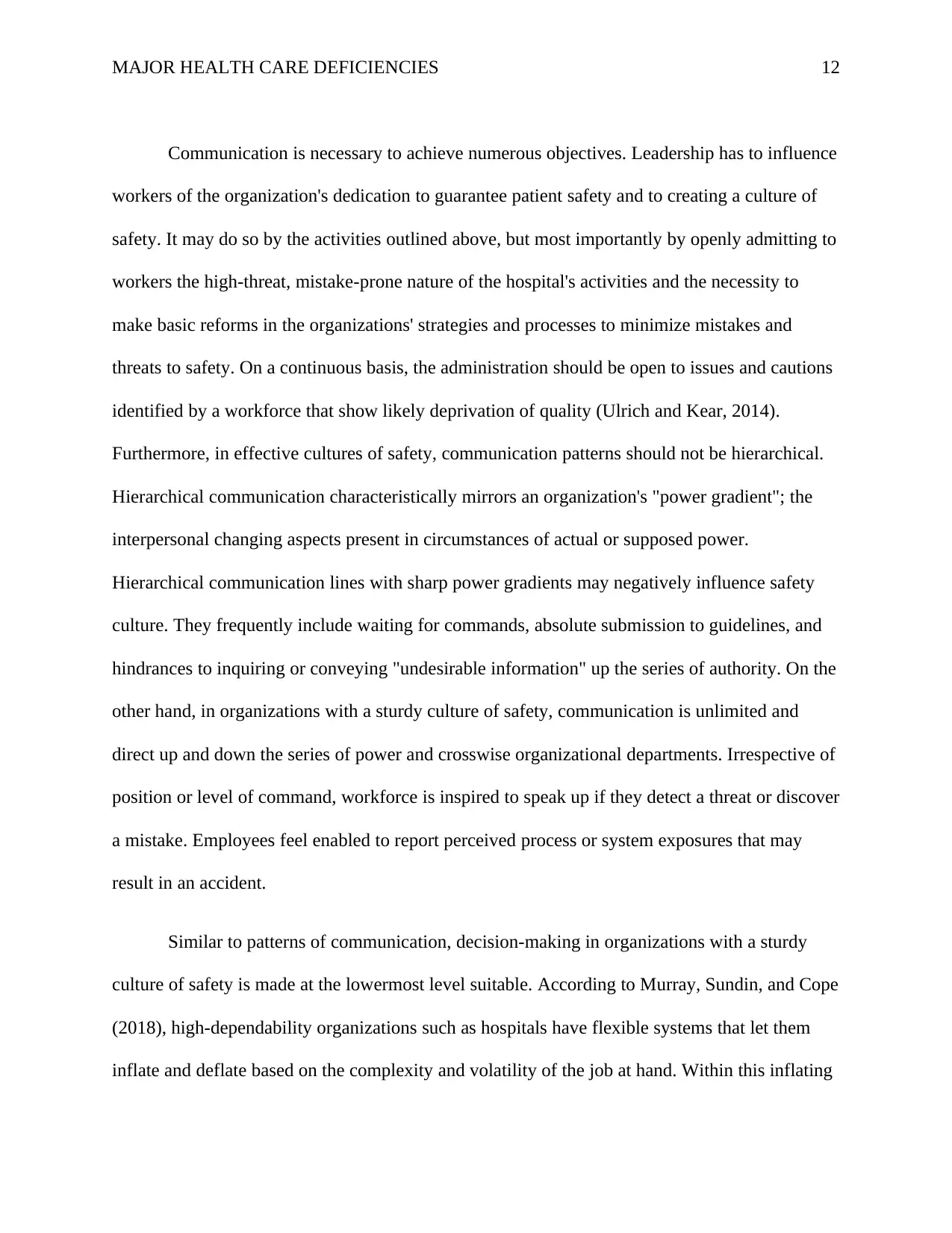
MAJOR HEALTH CARE DEFICIENCIES 12
Communication is necessary to achieve numerous objectives. Leadership has to influence
workers of the organization's dedication to guarantee patient safety and to creating a culture of
safety. It may do so by the activities outlined above, but most importantly by openly admitting to
workers the high-threat, mistake-prone nature of the hospital's activities and the necessity to
make basic reforms in the organizations' strategies and processes to minimize mistakes and
threats to safety. On a continuous basis, the administration should be open to issues and cautions
identified by a workforce that show likely deprivation of quality (Ulrich and Kear, 2014).
Furthermore, in effective cultures of safety, communication patterns should not be hierarchical.
Hierarchical communication characteristically mirrors an organization's "power gradient"; the
interpersonal changing aspects present in circumstances of actual or supposed power.
Hierarchical communication lines with sharp power gradients may negatively influence safety
culture. They frequently include waiting for commands, absolute submission to guidelines, and
hindrances to inquiring or conveying "undesirable information" up the series of authority. On the
other hand, in organizations with a sturdy culture of safety, communication is unlimited and
direct up and down the series of power and crosswise organizational departments. Irrespective of
position or level of command, workforce is inspired to speak up if they detect a threat or discover
a mistake. Employees feel enabled to report perceived process or system exposures that may
result in an accident.
Similar to patterns of communication, decision-making in organizations with a sturdy
culture of safety is made at the lowermost level suitable. According to Murray, Sundin, and Cope
(2018), high-dependability organizations such as hospitals have flexible systems that let them
inflate and deflate based on the complexity and volatility of the job at hand. Within this inflating
Communication is necessary to achieve numerous objectives. Leadership has to influence
workers of the organization's dedication to guarantee patient safety and to creating a culture of
safety. It may do so by the activities outlined above, but most importantly by openly admitting to
workers the high-threat, mistake-prone nature of the hospital's activities and the necessity to
make basic reforms in the organizations' strategies and processes to minimize mistakes and
threats to safety. On a continuous basis, the administration should be open to issues and cautions
identified by a workforce that show likely deprivation of quality (Ulrich and Kear, 2014).
Furthermore, in effective cultures of safety, communication patterns should not be hierarchical.
Hierarchical communication characteristically mirrors an organization's "power gradient"; the
interpersonal changing aspects present in circumstances of actual or supposed power.
Hierarchical communication lines with sharp power gradients may negatively influence safety
culture. They frequently include waiting for commands, absolute submission to guidelines, and
hindrances to inquiring or conveying "undesirable information" up the series of authority. On the
other hand, in organizations with a sturdy culture of safety, communication is unlimited and
direct up and down the series of power and crosswise organizational departments. Irrespective of
position or level of command, workforce is inspired to speak up if they detect a threat or discover
a mistake. Employees feel enabled to report perceived process or system exposures that may
result in an accident.
Similar to patterns of communication, decision-making in organizations with a sturdy
culture of safety is made at the lowermost level suitable. According to Murray, Sundin, and Cope
(2018), high-dependability organizations such as hospitals have flexible systems that let them
inflate and deflate based on the complexity and volatility of the job at hand. Within this inflating
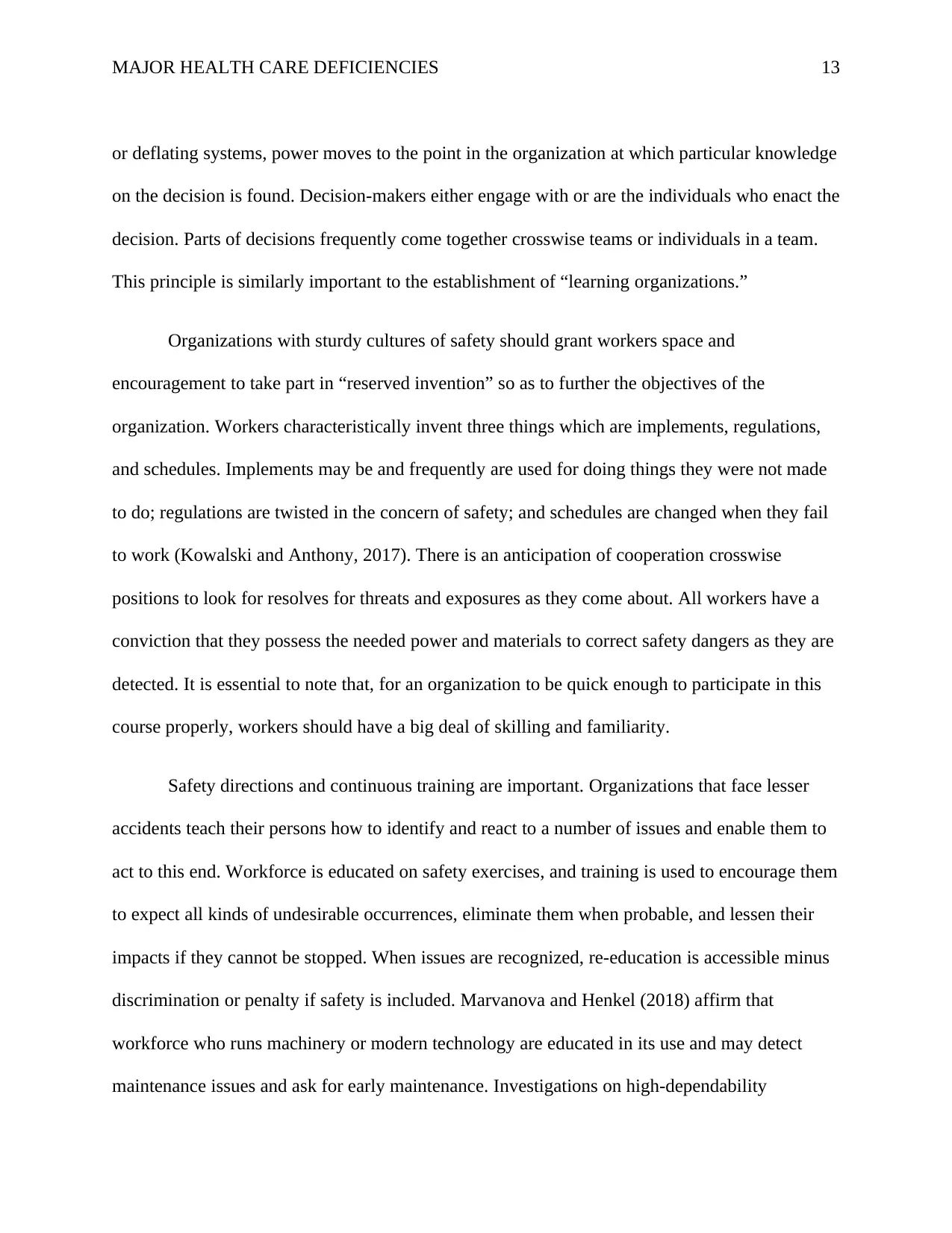
MAJOR HEALTH CARE DEFICIENCIES 13
or deflating systems, power moves to the point in the organization at which particular knowledge
on the decision is found. Decision-makers either engage with or are the individuals who enact the
decision. Parts of decisions frequently come together crosswise teams or individuals in a team.
This principle is similarly important to the establishment of “learning organizations.”
Organizations with sturdy cultures of safety should grant workers space and
encouragement to take part in “reserved invention” so as to further the objectives of the
organization. Workers characteristically invent three things which are implements, regulations,
and schedules. Implements may be and frequently are used for doing things they were not made
to do; regulations are twisted in the concern of safety; and schedules are changed when they fail
to work (Kowalski and Anthony, 2017). There is an anticipation of cooperation crosswise
positions to look for resolves for threats and exposures as they come about. All workers have a
conviction that they possess the needed power and materials to correct safety dangers as they are
detected. It is essential to note that, for an organization to be quick enough to participate in this
course properly, workers should have a big deal of skilling and familiarity.
Safety directions and continuous training are important. Organizations that face lesser
accidents teach their persons how to identify and react to a number of issues and enable them to
act to this end. Workforce is educated on safety exercises, and training is used to encourage them
to expect all kinds of undesirable occurrences, eliminate them when probable, and lessen their
impacts if they cannot be stopped. When issues are recognized, re-education is accessible minus
discrimination or penalty if safety is included. Marvanova and Henkel (2018) affirm that
workforce who runs machinery or modern technology are educated in its use and may detect
maintenance issues and ask for early maintenance. Investigations on high-dependability
or deflating systems, power moves to the point in the organization at which particular knowledge
on the decision is found. Decision-makers either engage with or are the individuals who enact the
decision. Parts of decisions frequently come together crosswise teams or individuals in a team.
This principle is similarly important to the establishment of “learning organizations.”
Organizations with sturdy cultures of safety should grant workers space and
encouragement to take part in “reserved invention” so as to further the objectives of the
organization. Workers characteristically invent three things which are implements, regulations,
and schedules. Implements may be and frequently are used for doing things they were not made
to do; regulations are twisted in the concern of safety; and schedules are changed when they fail
to work (Kowalski and Anthony, 2017). There is an anticipation of cooperation crosswise
positions to look for resolves for threats and exposures as they come about. All workers have a
conviction that they possess the needed power and materials to correct safety dangers as they are
detected. It is essential to note that, for an organization to be quick enough to participate in this
course properly, workers should have a big deal of skilling and familiarity.
Safety directions and continuous training are important. Organizations that face lesser
accidents teach their persons how to identify and react to a number of issues and enable them to
act to this end. Workforce is educated on safety exercises, and training is used to encourage them
to expect all kinds of undesirable occurrences, eliminate them when probable, and lessen their
impacts if they cannot be stopped. When issues are recognized, re-education is accessible minus
discrimination or penalty if safety is included. Marvanova and Henkel (2018) affirm that
workforce who runs machinery or modern technology are educated in its use and may detect
maintenance issues and ask for early maintenance. Investigations on high-dependability
Paraphrase This Document
Need a fresh take? Get an instant paraphrase of this document with our AI Paraphraser
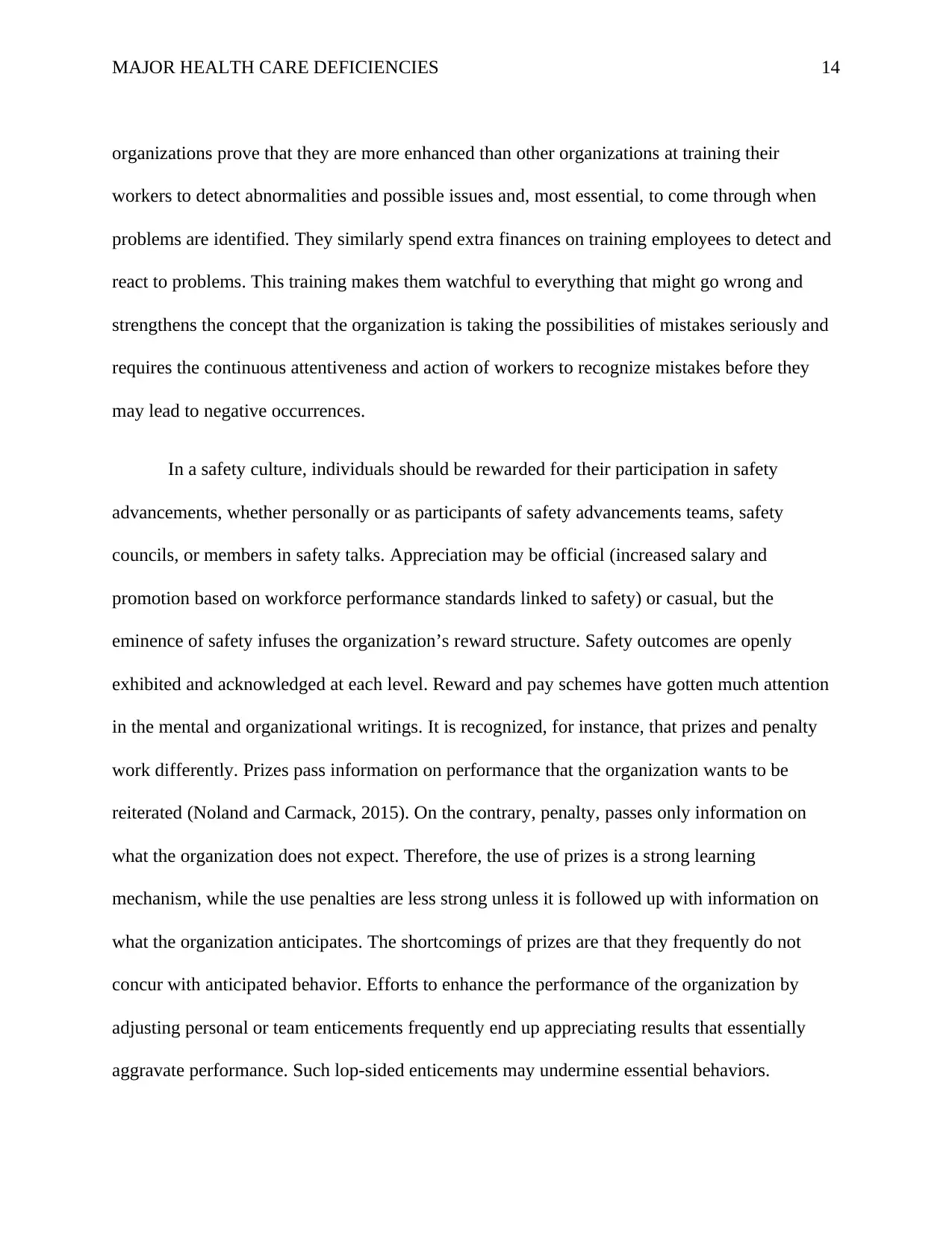
MAJOR HEALTH CARE DEFICIENCIES 14
organizations prove that they are more enhanced than other organizations at training their
workers to detect abnormalities and possible issues and, most essential, to come through when
problems are identified. They similarly spend extra finances on training employees to detect and
react to problems. This training makes them watchful to everything that might go wrong and
strengthens the concept that the organization is taking the possibilities of mistakes seriously and
requires the continuous attentiveness and action of workers to recognize mistakes before they
may lead to negative occurrences.
In a safety culture, individuals should be rewarded for their participation in safety
advancements, whether personally or as participants of safety advancements teams, safety
councils, or members in safety talks. Appreciation may be official (increased salary and
promotion based on workforce performance standards linked to safety) or casual, but the
eminence of safety infuses the organization’s reward structure. Safety outcomes are openly
exhibited and acknowledged at each level. Reward and pay schemes have gotten much attention
in the mental and organizational writings. It is recognized, for instance, that prizes and penalty
work differently. Prizes pass information on performance that the organization wants to be
reiterated (Noland and Carmack, 2015). On the contrary, penalty, passes only information on
what the organization does not expect. Therefore, the use of prizes is a strong learning
mechanism, while the use penalties are less strong unless it is followed up with information on
what the organization anticipates. The shortcomings of prizes are that they frequently do not
concur with anticipated behavior. Efforts to enhance the performance of the organization by
adjusting personal or team enticements frequently end up appreciating results that essentially
aggravate performance. Such lop-sided enticements may undermine essential behaviors.
organizations prove that they are more enhanced than other organizations at training their
workers to detect abnormalities and possible issues and, most essential, to come through when
problems are identified. They similarly spend extra finances on training employees to detect and
react to problems. This training makes them watchful to everything that might go wrong and
strengthens the concept that the organization is taking the possibilities of mistakes seriously and
requires the continuous attentiveness and action of workers to recognize mistakes before they
may lead to negative occurrences.
In a safety culture, individuals should be rewarded for their participation in safety
advancements, whether personally or as participants of safety advancements teams, safety
councils, or members in safety talks. Appreciation may be official (increased salary and
promotion based on workforce performance standards linked to safety) or casual, but the
eminence of safety infuses the organization’s reward structure. Safety outcomes are openly
exhibited and acknowledged at each level. Reward and pay schemes have gotten much attention
in the mental and organizational writings. It is recognized, for instance, that prizes and penalty
work differently. Prizes pass information on performance that the organization wants to be
reiterated (Noland and Carmack, 2015). On the contrary, penalty, passes only information on
what the organization does not expect. Therefore, the use of prizes is a strong learning
mechanism, while the use penalties are less strong unless it is followed up with information on
what the organization anticipates. The shortcomings of prizes are that they frequently do not
concur with anticipated behavior. Efforts to enhance the performance of the organization by
adjusting personal or team enticements frequently end up appreciating results that essentially
aggravate performance. Such lop-sided enticements may undermine essential behaviors.
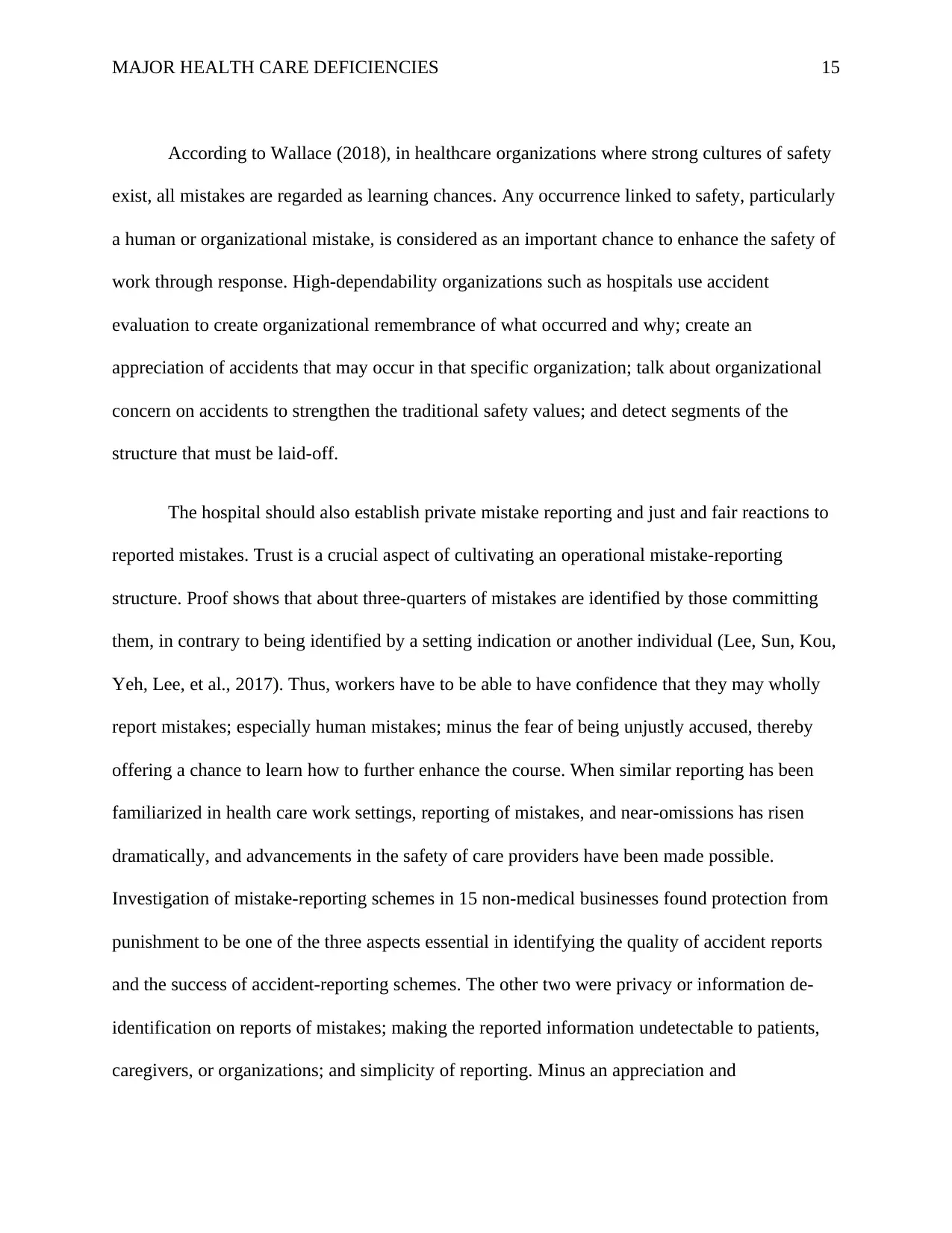
MAJOR HEALTH CARE DEFICIENCIES 15
According to Wallace (2018), in healthcare organizations where strong cultures of safety
exist, all mistakes are regarded as learning chances. Any occurrence linked to safety, particularly
a human or organizational mistake, is considered as an important chance to enhance the safety of
work through response. High-dependability organizations such as hospitals use accident
evaluation to create organizational remembrance of what occurred and why; create an
appreciation of accidents that may occur in that specific organization; talk about organizational
concern on accidents to strengthen the traditional safety values; and detect segments of the
structure that must be laid-off.
The hospital should also establish private mistake reporting and just and fair reactions to
reported mistakes. Trust is a crucial aspect of cultivating an operational mistake-reporting
structure. Proof shows that about three-quarters of mistakes are identified by those committing
them, in contrary to being identified by a setting indication or another individual (Lee, Sun, Kou,
Yeh, Lee, et al., 2017). Thus, workers have to be able to have confidence that they may wholly
report mistakes; especially human mistakes; minus the fear of being unjustly accused, thereby
offering a chance to learn how to further enhance the course. When similar reporting has been
familiarized in health care work settings, reporting of mistakes, and near-omissions has risen
dramatically, and advancements in the safety of care providers have been made possible.
Investigation of mistake-reporting schemes in 15 non-medical businesses found protection from
punishment to be one of the three aspects essential in identifying the quality of accident reports
and the success of accident-reporting schemes. The other two were privacy or information de-
identification on reports of mistakes; making the reported information undetectable to patients,
caregivers, or organizations; and simplicity of reporting. Minus an appreciation and
According to Wallace (2018), in healthcare organizations where strong cultures of safety
exist, all mistakes are regarded as learning chances. Any occurrence linked to safety, particularly
a human or organizational mistake, is considered as an important chance to enhance the safety of
work through response. High-dependability organizations such as hospitals use accident
evaluation to create organizational remembrance of what occurred and why; create an
appreciation of accidents that may occur in that specific organization; talk about organizational
concern on accidents to strengthen the traditional safety values; and detect segments of the
structure that must be laid-off.
The hospital should also establish private mistake reporting and just and fair reactions to
reported mistakes. Trust is a crucial aspect of cultivating an operational mistake-reporting
structure. Proof shows that about three-quarters of mistakes are identified by those committing
them, in contrary to being identified by a setting indication or another individual (Lee, Sun, Kou,
Yeh, Lee, et al., 2017). Thus, workers have to be able to have confidence that they may wholly
report mistakes; especially human mistakes; minus the fear of being unjustly accused, thereby
offering a chance to learn how to further enhance the course. When similar reporting has been
familiarized in health care work settings, reporting of mistakes, and near-omissions has risen
dramatically, and advancements in the safety of care providers have been made possible.
Investigation of mistake-reporting schemes in 15 non-medical businesses found protection from
punishment to be one of the three aspects essential in identifying the quality of accident reports
and the success of accident-reporting schemes. The other two were privacy or information de-
identification on reports of mistakes; making the reported information undetectable to patients,
caregivers, or organizations; and simplicity of reporting. Minus an appreciation and
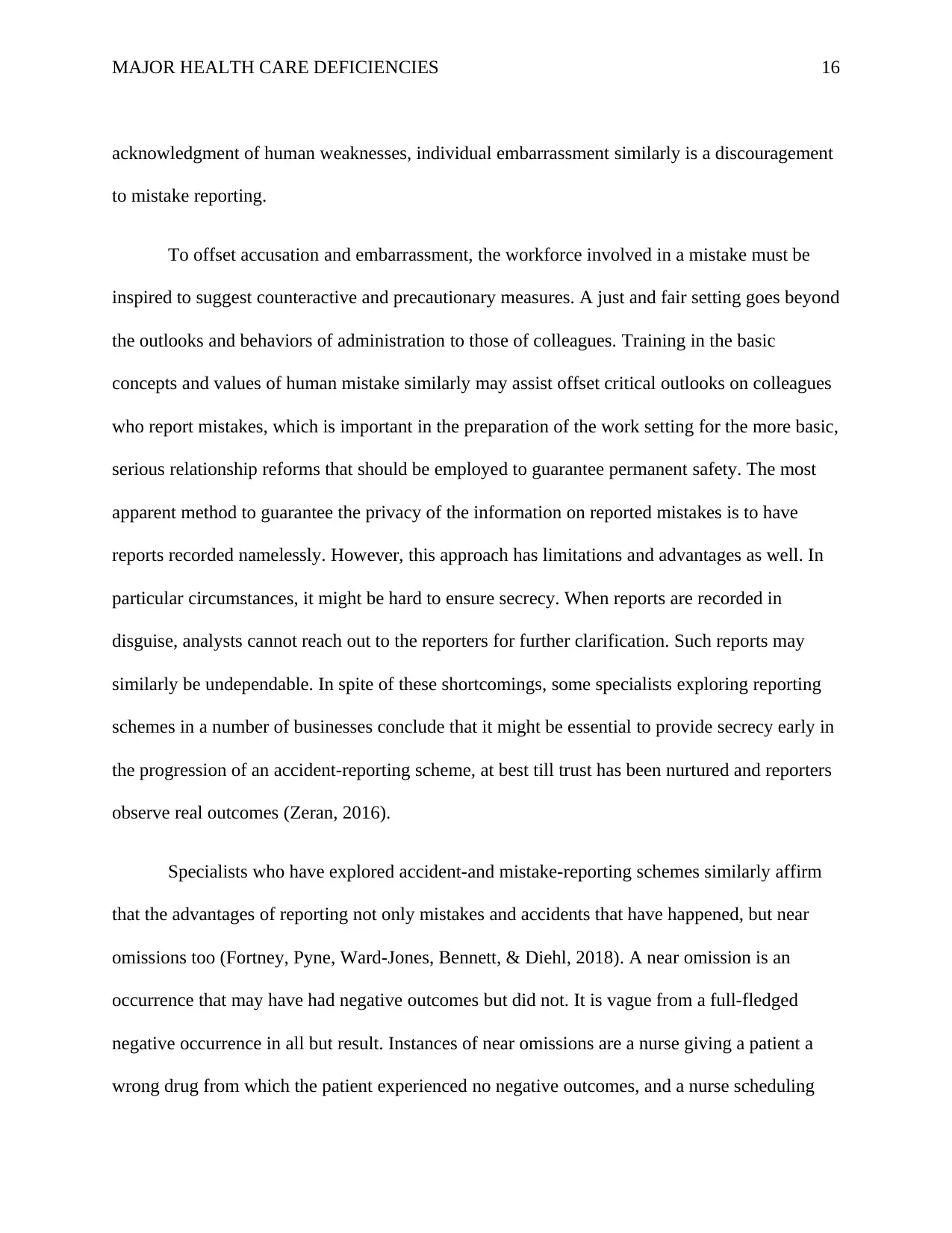
MAJOR HEALTH CARE DEFICIENCIES 16
acknowledgment of human weaknesses, individual embarrassment similarly is a discouragement
to mistake reporting.
To offset accusation and embarrassment, the workforce involved in a mistake must be
inspired to suggest counteractive and precautionary measures. A just and fair setting goes beyond
the outlooks and behaviors of administration to those of colleagues. Training in the basic
concepts and values of human mistake similarly may assist offset critical outlooks on colleagues
who report mistakes, which is important in the preparation of the work setting for the more basic,
serious relationship reforms that should be employed to guarantee permanent safety. The most
apparent method to guarantee the privacy of the information on reported mistakes is to have
reports recorded namelessly. However, this approach has limitations and advantages as well. In
particular circumstances, it might be hard to ensure secrecy. When reports are recorded in
disguise, analysts cannot reach out to the reporters for further clarification. Such reports may
similarly be undependable. In spite of these shortcomings, some specialists exploring reporting
schemes in a number of businesses conclude that it might be essential to provide secrecy early in
the progression of an accident-reporting scheme, at best till trust has been nurtured and reporters
observe real outcomes (Zeran, 2016).
Specialists who have explored accident-and mistake-reporting schemes similarly affirm
that the advantages of reporting not only mistakes and accidents that have happened, but near
omissions too (Fortney, Pyne, Ward-Jones, Bennett, & Diehl, 2018). A near omission is an
occurrence that may have had negative outcomes but did not. It is vague from a full-fledged
negative occurrence in all but result. Instances of near omissions are a nurse giving a patient a
wrong drug from which the patient experienced no negative outcomes, and a nurse scheduling
acknowledgment of human weaknesses, individual embarrassment similarly is a discouragement
to mistake reporting.
To offset accusation and embarrassment, the workforce involved in a mistake must be
inspired to suggest counteractive and precautionary measures. A just and fair setting goes beyond
the outlooks and behaviors of administration to those of colleagues. Training in the basic
concepts and values of human mistake similarly may assist offset critical outlooks on colleagues
who report mistakes, which is important in the preparation of the work setting for the more basic,
serious relationship reforms that should be employed to guarantee permanent safety. The most
apparent method to guarantee the privacy of the information on reported mistakes is to have
reports recorded namelessly. However, this approach has limitations and advantages as well. In
particular circumstances, it might be hard to ensure secrecy. When reports are recorded in
disguise, analysts cannot reach out to the reporters for further clarification. Such reports may
similarly be undependable. In spite of these shortcomings, some specialists exploring reporting
schemes in a number of businesses conclude that it might be essential to provide secrecy early in
the progression of an accident-reporting scheme, at best till trust has been nurtured and reporters
observe real outcomes (Zeran, 2016).
Specialists who have explored accident-and mistake-reporting schemes similarly affirm
that the advantages of reporting not only mistakes and accidents that have happened, but near
omissions too (Fortney, Pyne, Ward-Jones, Bennett, & Diehl, 2018). A near omission is an
occurrence that may have had negative outcomes but did not. It is vague from a full-fledged
negative occurrence in all but result. Instances of near omissions are a nurse giving a patient a
wrong drug from which the patient experienced no negative outcomes, and a nurse scheduling
Secure Best Marks with AI Grader
Need help grading? Try our AI Grader for instant feedback on your assignments.
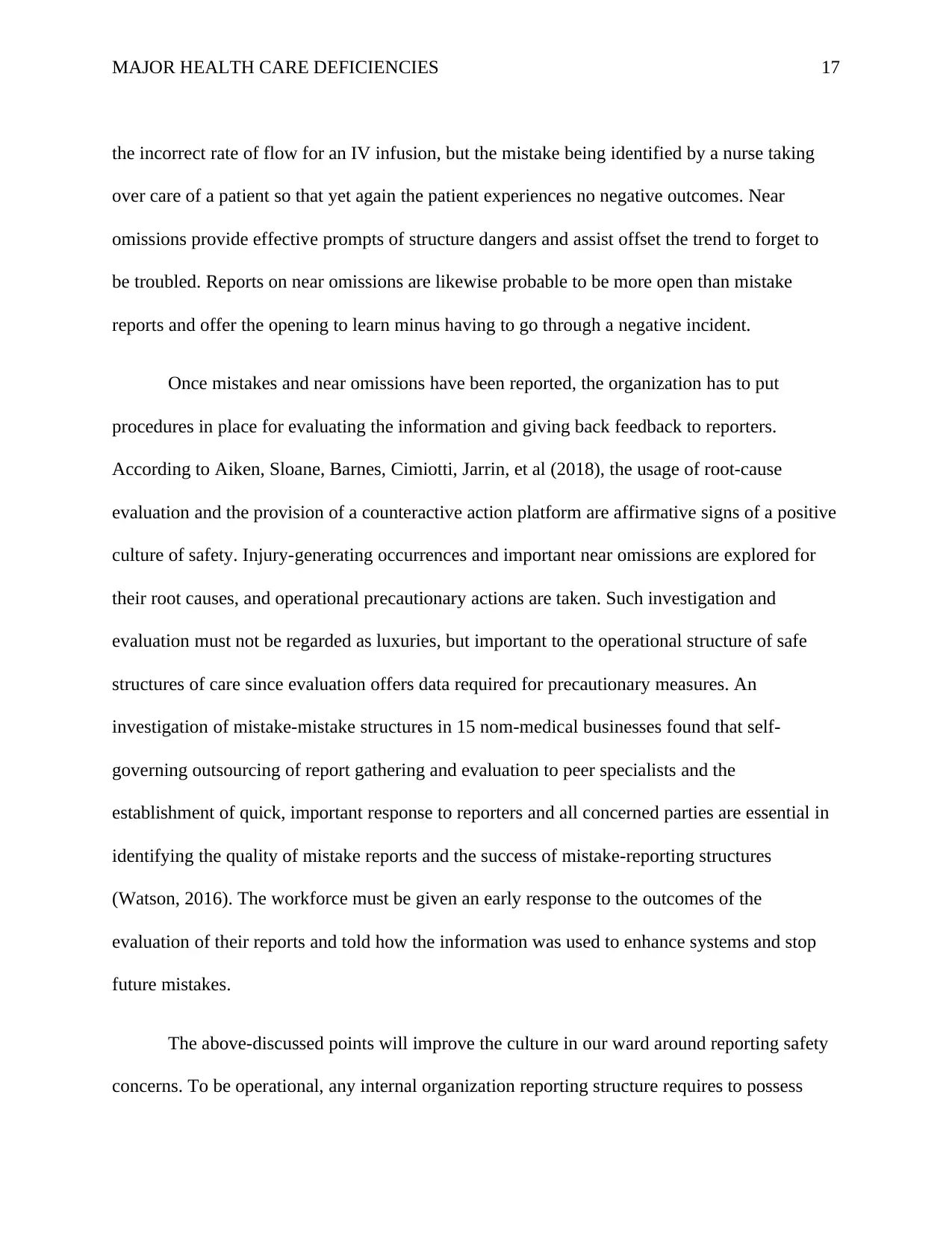
MAJOR HEALTH CARE DEFICIENCIES 17
the incorrect rate of flow for an IV infusion, but the mistake being identified by a nurse taking
over care of a patient so that yet again the patient experiences no negative outcomes. Near
omissions provide effective prompts of structure dangers and assist offset the trend to forget to
be troubled. Reports on near omissions are likewise probable to be more open than mistake
reports and offer the opening to learn minus having to go through a negative incident.
Once mistakes and near omissions have been reported, the organization has to put
procedures in place for evaluating the information and giving back feedback to reporters.
According to Aiken, Sloane, Barnes, Cimiotti, Jarrin, et al (2018), the usage of root-cause
evaluation and the provision of a counteractive action platform are affirmative signs of a positive
culture of safety. Injury-generating occurrences and important near omissions are explored for
their root causes, and operational precautionary actions are taken. Such investigation and
evaluation must not be regarded as luxuries, but important to the operational structure of safe
structures of care since evaluation offers data required for precautionary measures. An
investigation of mistake-mistake structures in 15 nom-medical businesses found that self-
governing outsourcing of report gathering and evaluation to peer specialists and the
establishment of quick, important response to reporters and all concerned parties are essential in
identifying the quality of mistake reports and the success of mistake-reporting structures
(Watson, 2016). The workforce must be given an early response to the outcomes of the
evaluation of their reports and told how the information was used to enhance systems and stop
future mistakes.
The above-discussed points will improve the culture in our ward around reporting safety
concerns. To be operational, any internal organization reporting structure requires to possess
the incorrect rate of flow for an IV infusion, but the mistake being identified by a nurse taking
over care of a patient so that yet again the patient experiences no negative outcomes. Near
omissions provide effective prompts of structure dangers and assist offset the trend to forget to
be troubled. Reports on near omissions are likewise probable to be more open than mistake
reports and offer the opening to learn minus having to go through a negative incident.
Once mistakes and near omissions have been reported, the organization has to put
procedures in place for evaluating the information and giving back feedback to reporters.
According to Aiken, Sloane, Barnes, Cimiotti, Jarrin, et al (2018), the usage of root-cause
evaluation and the provision of a counteractive action platform are affirmative signs of a positive
culture of safety. Injury-generating occurrences and important near omissions are explored for
their root causes, and operational precautionary actions are taken. Such investigation and
evaluation must not be regarded as luxuries, but important to the operational structure of safe
structures of care since evaluation offers data required for precautionary measures. An
investigation of mistake-mistake structures in 15 nom-medical businesses found that self-
governing outsourcing of report gathering and evaluation to peer specialists and the
establishment of quick, important response to reporters and all concerned parties are essential in
identifying the quality of mistake reports and the success of mistake-reporting structures
(Watson, 2016). The workforce must be given an early response to the outcomes of the
evaluation of their reports and told how the information was used to enhance systems and stop
future mistakes.
The above-discussed points will improve the culture in our ward around reporting safety
concerns. To be operational, any internal organization reporting structure requires to possess
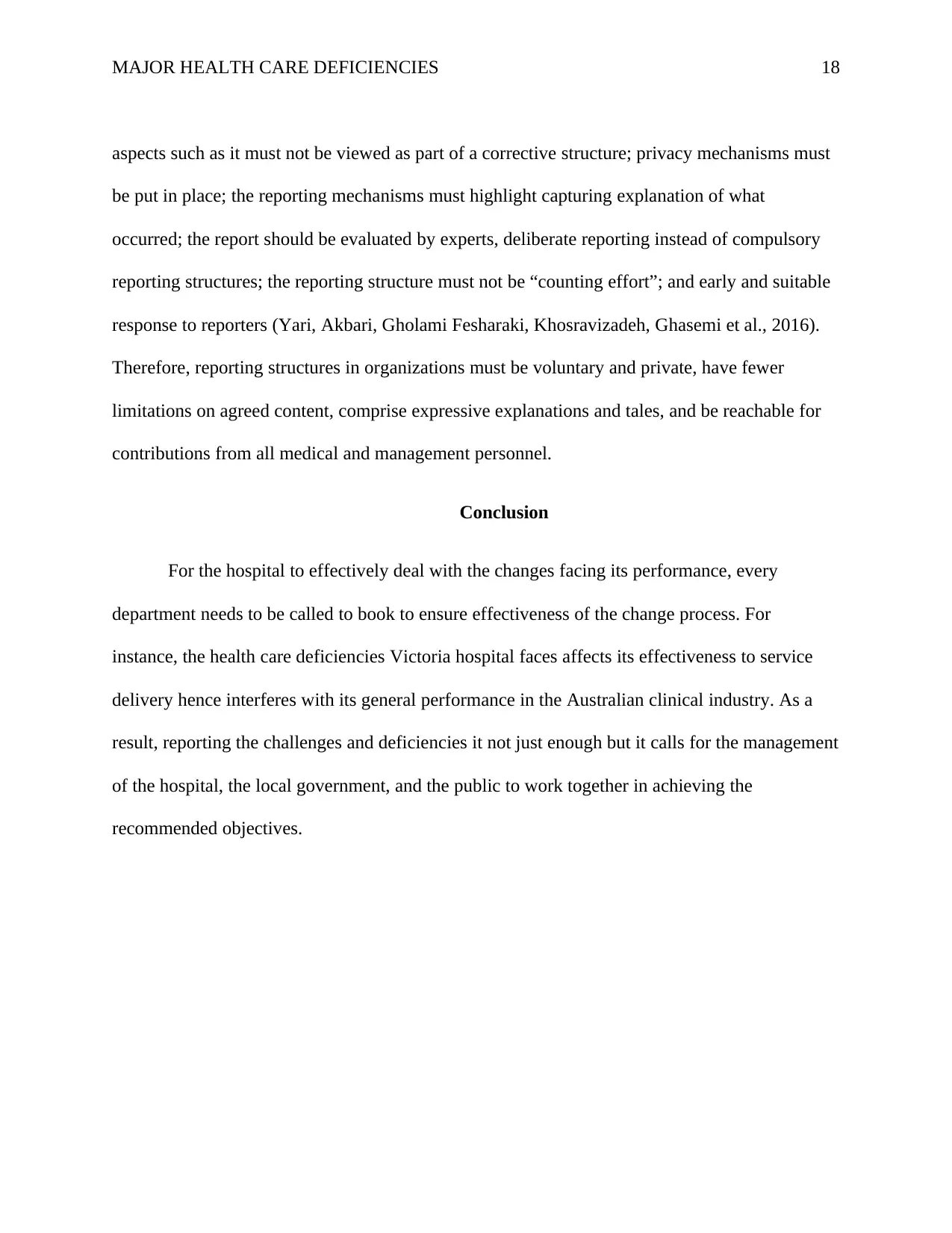
MAJOR HEALTH CARE DEFICIENCIES 18
aspects such as it must not be viewed as part of a corrective structure; privacy mechanisms must
be put in place; the reporting mechanisms must highlight capturing explanation of what
occurred; the report should be evaluated by experts, deliberate reporting instead of compulsory
reporting structures; the reporting structure must not be “counting effort”; and early and suitable
response to reporters (Yari, Akbari, Gholami Fesharaki, Khosravizadeh, Ghasemi et al., 2016).
Therefore, reporting structures in organizations must be voluntary and private, have fewer
limitations on agreed content, comprise expressive explanations and tales, and be reachable for
contributions from all medical and management personnel.
Conclusion
For the hospital to effectively deal with the changes facing its performance, every
department needs to be called to book to ensure effectiveness of the change process. For
instance, the health care deficiencies Victoria hospital faces affects its effectiveness to service
delivery hence interferes with its general performance in the Australian clinical industry. As a
result, reporting the challenges and deficiencies it not just enough but it calls for the management
of the hospital, the local government, and the public to work together in achieving the
recommended objectives.
aspects such as it must not be viewed as part of a corrective structure; privacy mechanisms must
be put in place; the reporting mechanisms must highlight capturing explanation of what
occurred; the report should be evaluated by experts, deliberate reporting instead of compulsory
reporting structures; the reporting structure must not be “counting effort”; and early and suitable
response to reporters (Yari, Akbari, Gholami Fesharaki, Khosravizadeh, Ghasemi et al., 2016).
Therefore, reporting structures in organizations must be voluntary and private, have fewer
limitations on agreed content, comprise expressive explanations and tales, and be reachable for
contributions from all medical and management personnel.
Conclusion
For the hospital to effectively deal with the changes facing its performance, every
department needs to be called to book to ensure effectiveness of the change process. For
instance, the health care deficiencies Victoria hospital faces affects its effectiveness to service
delivery hence interferes with its general performance in the Australian clinical industry. As a
result, reporting the challenges and deficiencies it not just enough but it calls for the management
of the hospital, the local government, and the public to work together in achieving the
recommended objectives.
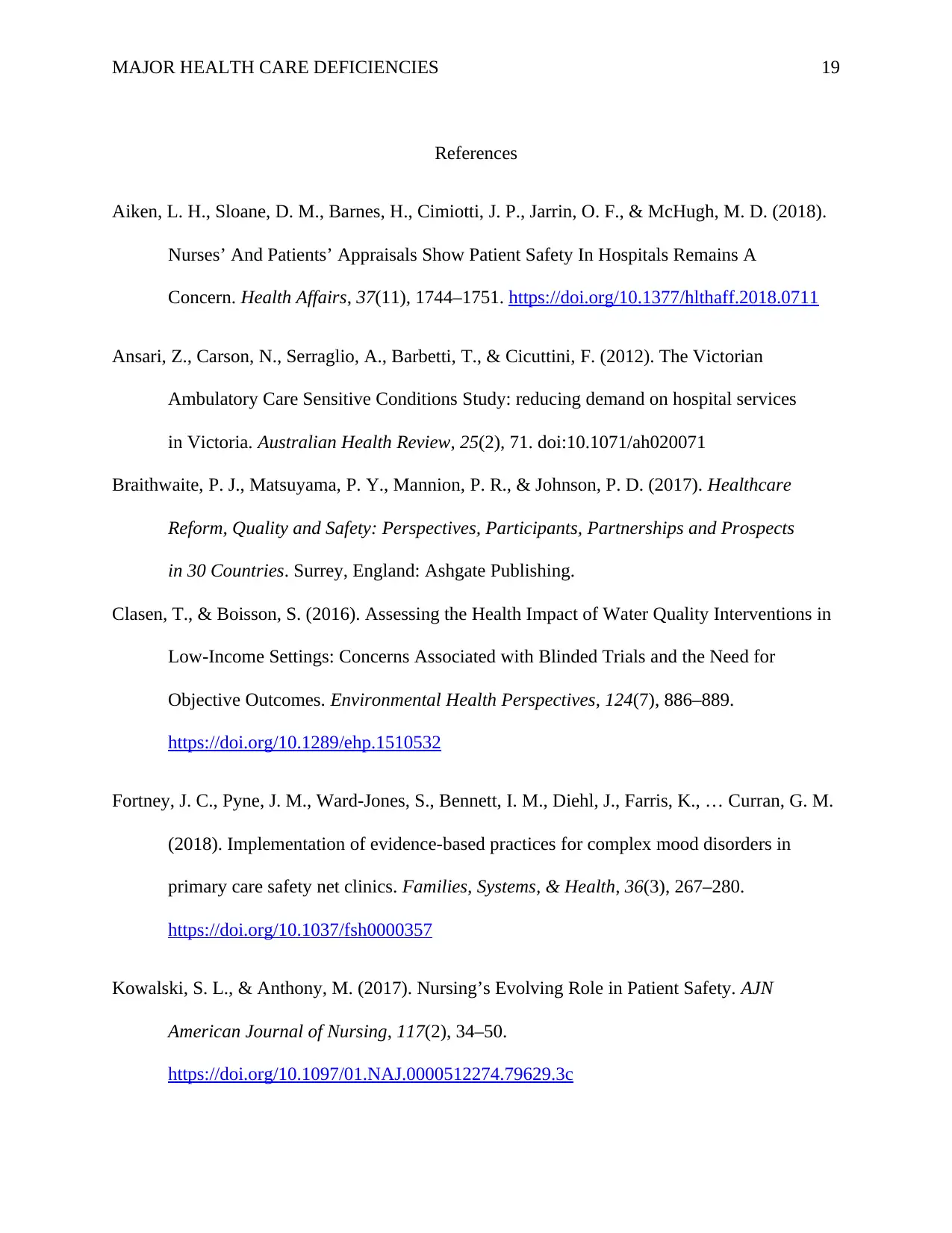
MAJOR HEALTH CARE DEFICIENCIES 19
References
Aiken, L. H., Sloane, D. M., Barnes, H., Cimiotti, J. P., Jarrin, O. F., & McHugh, M. D. (2018).
Nurses’ And Patients’ Appraisals Show Patient Safety In Hospitals Remains A
Concern. Health Affairs, 37(11), 1744–1751. https://doi.org/10.1377/hlthaff.2018.0711
Ansari, Z., Carson, N., Serraglio, A., Barbetti, T., & Cicuttini, F. (2012). The Victorian
Ambulatory Care Sensitive Conditions Study: reducing demand on hospital services
in Victoria. Australian Health Review, 25(2), 71. doi:10.1071/ah020071
Braithwaite, P. J., Matsuyama, P. Y., Mannion, P. R., & Johnson, P. D. (2017). Healthcare
Reform, Quality and Safety: Perspectives, Participants, Partnerships and Prospects
in 30 Countries. Surrey, England: Ashgate Publishing.
Clasen, T., & Boisson, S. (2016). Assessing the Health Impact of Water Quality Interventions in
Low-Income Settings: Concerns Associated with Blinded Trials and the Need for
Objective Outcomes. Environmental Health Perspectives, 124(7), 886–889.
https://doi.org/10.1289/ehp.1510532
Fortney, J. C., Pyne, J. M., Ward-Jones, S., Bennett, I. M., Diehl, J., Farris, K., … Curran, G. M.
(2018). Implementation of evidence-based practices for complex mood disorders in
primary care safety net clinics. Families, Systems, & Health, 36(3), 267–280.
https://doi.org/10.1037/fsh0000357
Kowalski, S. L., & Anthony, M. (2017). Nursing’s Evolving Role in Patient Safety. AJN
American Journal of Nursing, 117(2), 34–50.
https://doi.org/10.1097/01.NAJ.0000512274.79629.3c
References
Aiken, L. H., Sloane, D. M., Barnes, H., Cimiotti, J. P., Jarrin, O. F., & McHugh, M. D. (2018).
Nurses’ And Patients’ Appraisals Show Patient Safety In Hospitals Remains A
Concern. Health Affairs, 37(11), 1744–1751. https://doi.org/10.1377/hlthaff.2018.0711
Ansari, Z., Carson, N., Serraglio, A., Barbetti, T., & Cicuttini, F. (2012). The Victorian
Ambulatory Care Sensitive Conditions Study: reducing demand on hospital services
in Victoria. Australian Health Review, 25(2), 71. doi:10.1071/ah020071
Braithwaite, P. J., Matsuyama, P. Y., Mannion, P. R., & Johnson, P. D. (2017). Healthcare
Reform, Quality and Safety: Perspectives, Participants, Partnerships and Prospects
in 30 Countries. Surrey, England: Ashgate Publishing.
Clasen, T., & Boisson, S. (2016). Assessing the Health Impact of Water Quality Interventions in
Low-Income Settings: Concerns Associated with Blinded Trials and the Need for
Objective Outcomes. Environmental Health Perspectives, 124(7), 886–889.
https://doi.org/10.1289/ehp.1510532
Fortney, J. C., Pyne, J. M., Ward-Jones, S., Bennett, I. M., Diehl, J., Farris, K., … Curran, G. M.
(2018). Implementation of evidence-based practices for complex mood disorders in
primary care safety net clinics. Families, Systems, & Health, 36(3), 267–280.
https://doi.org/10.1037/fsh0000357
Kowalski, S. L., & Anthony, M. (2017). Nursing’s Evolving Role in Patient Safety. AJN
American Journal of Nursing, 117(2), 34–50.
https://doi.org/10.1097/01.NAJ.0000512274.79629.3c
Paraphrase This Document
Need a fresh take? Get an instant paraphrase of this document with our AI Paraphraser
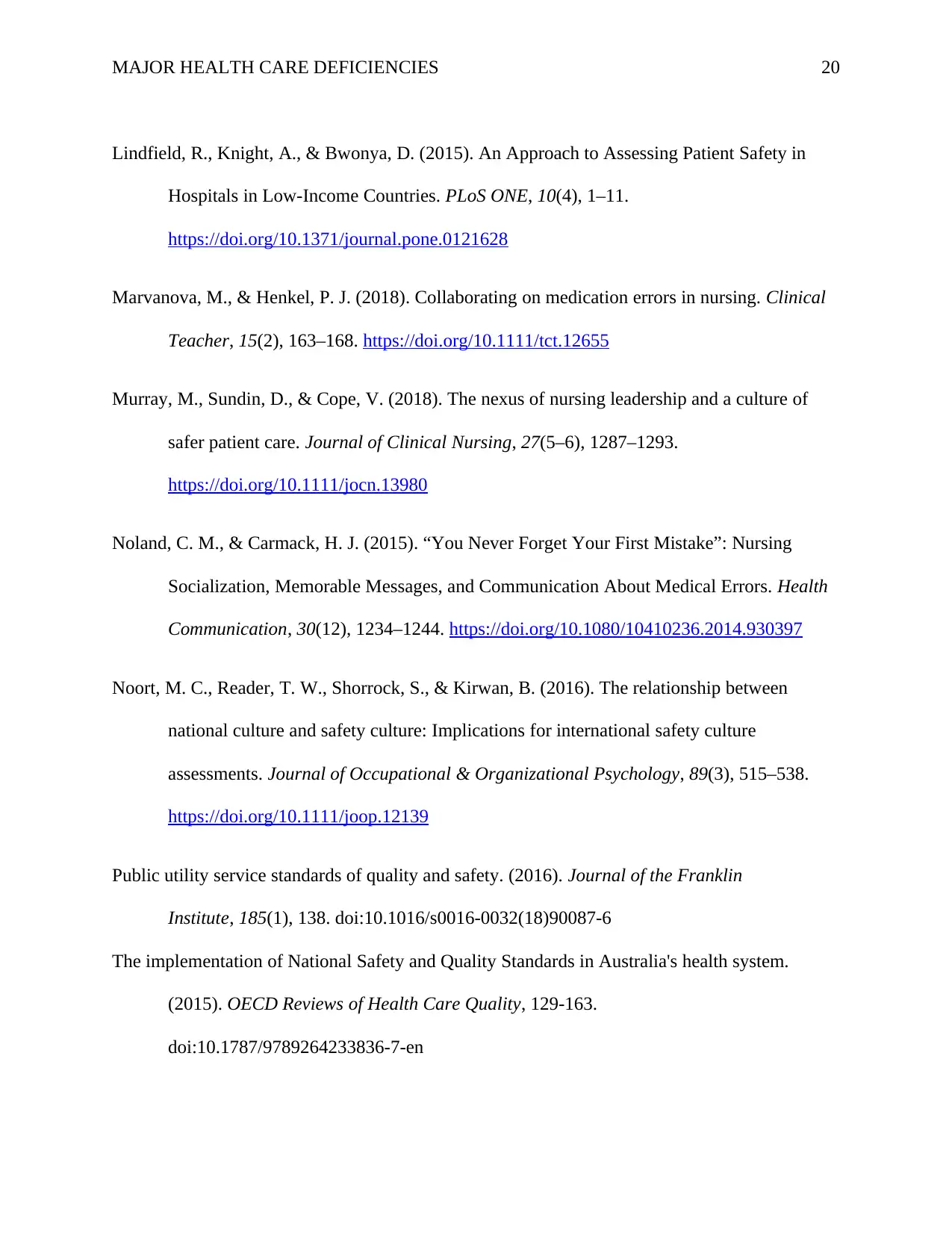
MAJOR HEALTH CARE DEFICIENCIES 20
Lindfield, R., Knight, A., & Bwonya, D. (2015). An Approach to Assessing Patient Safety in
Hospitals in Low-Income Countries. PLoS ONE, 10(4), 1–11.
https://doi.org/10.1371/journal.pone.0121628
Marvanova, M., & Henkel, P. J. (2018). Collaborating on medication errors in nursing. Clinical
Teacher, 15(2), 163–168. https://doi.org/10.1111/tct.12655
Murray, M., Sundin, D., & Cope, V. (2018). The nexus of nursing leadership and a culture of
safer patient care. Journal of Clinical Nursing, 27(5–6), 1287–1293.
https://doi.org/10.1111/jocn.13980
Noland, C. M., & Carmack, H. J. (2015). “You Never Forget Your First Mistake”: Nursing
Socialization, Memorable Messages, and Communication About Medical Errors. Health
Communication, 30(12), 1234–1244. https://doi.org/10.1080/10410236.2014.930397
Noort, M. C., Reader, T. W., Shorrock, S., & Kirwan, B. (2016). The relationship between
national culture and safety culture: Implications for international safety culture
assessments. Journal of Occupational & Organizational Psychology, 89(3), 515–538.
https://doi.org/10.1111/joop.12139
Public utility service standards of quality and safety. (2016). Journal of the Franklin
Institute, 185(1), 138. doi:10.1016/s0016-0032(18)90087-6
The implementation of National Safety and Quality Standards in Australia's health system.
(2015). OECD Reviews of Health Care Quality, 129-163.
doi:10.1787/9789264233836-7-en
Lindfield, R., Knight, A., & Bwonya, D. (2015). An Approach to Assessing Patient Safety in
Hospitals in Low-Income Countries. PLoS ONE, 10(4), 1–11.
https://doi.org/10.1371/journal.pone.0121628
Marvanova, M., & Henkel, P. J. (2018). Collaborating on medication errors in nursing. Clinical
Teacher, 15(2), 163–168. https://doi.org/10.1111/tct.12655
Murray, M., Sundin, D., & Cope, V. (2018). The nexus of nursing leadership and a culture of
safer patient care. Journal of Clinical Nursing, 27(5–6), 1287–1293.
https://doi.org/10.1111/jocn.13980
Noland, C. M., & Carmack, H. J. (2015). “You Never Forget Your First Mistake”: Nursing
Socialization, Memorable Messages, and Communication About Medical Errors. Health
Communication, 30(12), 1234–1244. https://doi.org/10.1080/10410236.2014.930397
Noort, M. C., Reader, T. W., Shorrock, S., & Kirwan, B. (2016). The relationship between
national culture and safety culture: Implications for international safety culture
assessments. Journal of Occupational & Organizational Psychology, 89(3), 515–538.
https://doi.org/10.1111/joop.12139
Public utility service standards of quality and safety. (2016). Journal of the Franklin
Institute, 185(1), 138. doi:10.1016/s0016-0032(18)90087-6
The implementation of National Safety and Quality Standards in Australia's health system.
(2015). OECD Reviews of Health Care Quality, 129-163.
doi:10.1787/9789264233836-7-en
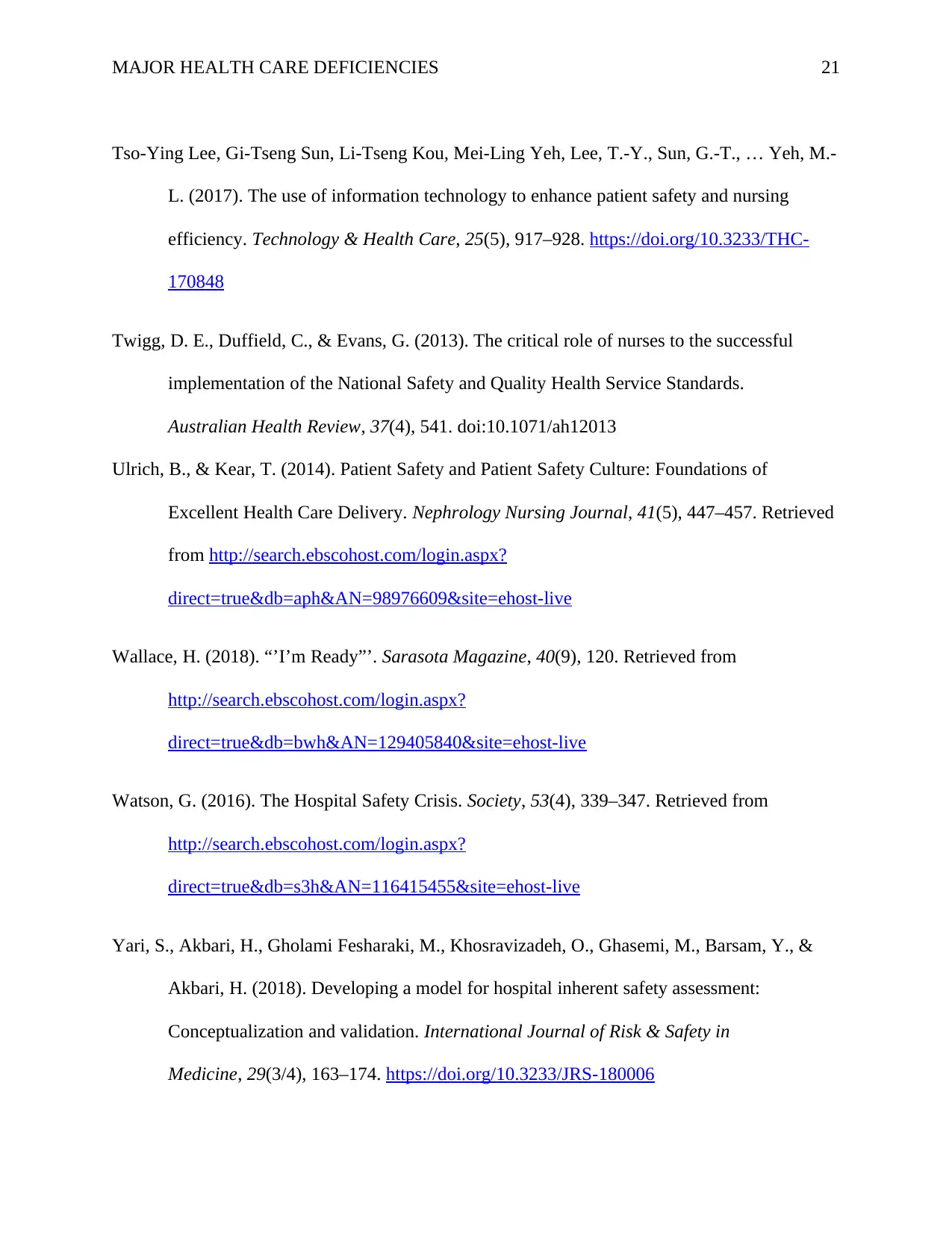
MAJOR HEALTH CARE DEFICIENCIES 21
Tso-Ying Lee, Gi-Tseng Sun, Li-Tseng Kou, Mei-Ling Yeh, Lee, T.-Y., Sun, G.-T., … Yeh, M.-
L. (2017). The use of information technology to enhance patient safety and nursing
efficiency. Technology & Health Care, 25(5), 917–928. https://doi.org/10.3233/THC-
170848
Twigg, D. E., Duffield, C., & Evans, G. (2013). The critical role of nurses to the successful
implementation of the National Safety and Quality Health Service Standards.
Australian Health Review, 37(4), 541. doi:10.1071/ah12013
Ulrich, B., & Kear, T. (2014). Patient Safety and Patient Safety Culture: Foundations of
Excellent Health Care Delivery. Nephrology Nursing Journal, 41(5), 447–457. Retrieved
from http://search.ebscohost.com/login.aspx?
direct=true&db=aph&AN=98976609&site=ehost-live
Wallace, H. (2018). “’I’m Ready”’. Sarasota Magazine, 40(9), 120. Retrieved from
http://search.ebscohost.com/login.aspx?
direct=true&db=bwh&AN=129405840&site=ehost-live
Watson, G. (2016). The Hospital Safety Crisis. Society, 53(4), 339–347. Retrieved from
http://search.ebscohost.com/login.aspx?
direct=true&db=s3h&AN=116415455&site=ehost-live
Yari, S., Akbari, H., Gholami Fesharaki, M., Khosravizadeh, O., Ghasemi, M., Barsam, Y., &
Akbari, H. (2018). Developing a model for hospital inherent safety assessment:
Conceptualization and validation. International Journal of Risk & Safety in
Medicine, 29(3/4), 163–174. https://doi.org/10.3233/JRS-180006
Tso-Ying Lee, Gi-Tseng Sun, Li-Tseng Kou, Mei-Ling Yeh, Lee, T.-Y., Sun, G.-T., … Yeh, M.-
L. (2017). The use of information technology to enhance patient safety and nursing
efficiency. Technology & Health Care, 25(5), 917–928. https://doi.org/10.3233/THC-
170848
Twigg, D. E., Duffield, C., & Evans, G. (2013). The critical role of nurses to the successful
implementation of the National Safety and Quality Health Service Standards.
Australian Health Review, 37(4), 541. doi:10.1071/ah12013
Ulrich, B., & Kear, T. (2014). Patient Safety and Patient Safety Culture: Foundations of
Excellent Health Care Delivery. Nephrology Nursing Journal, 41(5), 447–457. Retrieved
from http://search.ebscohost.com/login.aspx?
direct=true&db=aph&AN=98976609&site=ehost-live
Wallace, H. (2018). “’I’m Ready”’. Sarasota Magazine, 40(9), 120. Retrieved from
http://search.ebscohost.com/login.aspx?
direct=true&db=bwh&AN=129405840&site=ehost-live
Watson, G. (2016). The Hospital Safety Crisis. Society, 53(4), 339–347. Retrieved from
http://search.ebscohost.com/login.aspx?
direct=true&db=s3h&AN=116415455&site=ehost-live
Yari, S., Akbari, H., Gholami Fesharaki, M., Khosravizadeh, O., Ghasemi, M., Barsam, Y., &
Akbari, H. (2018). Developing a model for hospital inherent safety assessment:
Conceptualization and validation. International Journal of Risk & Safety in
Medicine, 29(3/4), 163–174. https://doi.org/10.3233/JRS-180006

MAJOR HEALTH CARE DEFICIENCIES 22
Young, S. (2007). Outsourcing: two case studies from the Victorian public hospital sector.
Australian Health Review, 31(1), 140. doi:10.1071/ah070140
Young, S. (2017). Outsourcing: two case studies from the Victorian public hospital sector.
Australian Health Review, 31(1), 140. doi:10.1071/ah070140
Zeran, V. (2016). Cultural Competency and Safety in Nursing Education: A Case
Study. Northern Review, (43), 105–115. Retrieved from
http://search.ebscohost.com/login.aspx?
direct=true&db=aph&AN=120486378&site=ehost-live
Young, S. (2007). Outsourcing: two case studies from the Victorian public hospital sector.
Australian Health Review, 31(1), 140. doi:10.1071/ah070140
Young, S. (2017). Outsourcing: two case studies from the Victorian public hospital sector.
Australian Health Review, 31(1), 140. doi:10.1071/ah070140
Zeran, V. (2016). Cultural Competency and Safety in Nursing Education: A Case
Study. Northern Review, (43), 105–115. Retrieved from
http://search.ebscohost.com/login.aspx?
direct=true&db=aph&AN=120486378&site=ehost-live
Secure Best Marks with AI Grader
Need help grading? Try our AI Grader for instant feedback on your assignments.
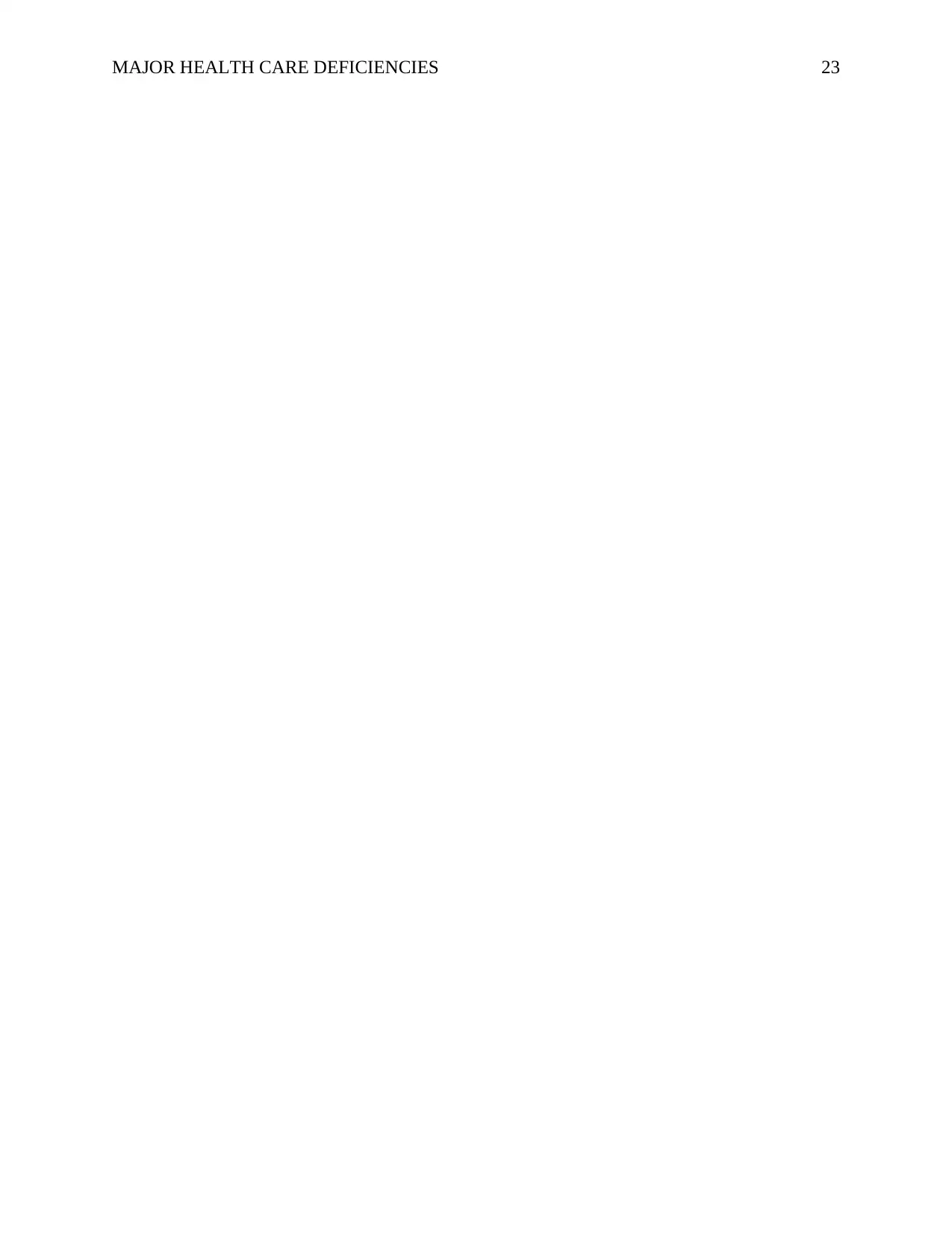
MAJOR HEALTH CARE DEFICIENCIES 23
1 out of 23
Related Documents
Your All-in-One AI-Powered Toolkit for Academic Success.
+13062052269
info@desklib.com
Available 24*7 on WhatsApp / Email
![[object Object]](/_next/static/media/star-bottom.7253800d.svg)
Unlock your academic potential
© 2024 | Zucol Services PVT LTD | All rights reserved.





